Technology
The planet Saturn; Features, number of moons, rings and wonders
Published
3 months agoon


The planet Saturn; Features, number of moons, rings, and wonders
Saturn is the sixth planet in terms of distance from the Sun and the second largest planet in the entire solar system. Saturn can be called the lord of the rings of the solar system due to its thousands of beautiful and unique rings. Like Jupiter, this planet is a gas giant with a radius 9 times that of Earth, while its density is one-eighth that of Earth.
Saturn’s internal structure is a mixture of iron, nickel, and rock (silicon and oxygen compounds). The core of the planet is surrounded by a layer of metallic hydrogen, the middle layer consists of liquid hydrogen and helium, and finally there is a gaseous outer layer. The reason for Saturn’s soft yellow color is the presence of ammonia crystals in its upper atmosphere. The electric current inside the metallic hydrogen layer has increased the magnetic field of this planet. The strength of Jupiter’s magnetic field is twenty-one times that of Saturn. The outer atmosphere of this planet is calm and without turbulence. The wind speed in some areas of Saturn reaches 1800 km/h, which is more than Jupiter.
From the collection of articles on the introduction of planets: The planet Mars; Everything you need to know
So far, at least 83 moons have been discovered in the orbit of Saturn, 53 of which have been officially named. The largest moon of Saturn, Titan, is the second largest moon in the solar system and is even larger than the planet Mercury. Titan is the only moon in the entire solar system that has a significant atmosphere. The most striking feature of Saturn is its ring system, which is a combination of ice particles and small pieces of rock.
-
What does the planet Saturn symbolize?
-
How was the planet Saturn formed?
-
Nucleus aggregation model
-
Disk instability model
-
Saturn is how many times the size of Earth?
-
Physical characteristics and internal composition of the planet Saturn
-
Saturn’s atmosphere and clouds
-
Saturn’s magnetic field
-
The orbit and rotation of Saturn
-
Rings of Saturn
-
How many moons does Saturn have?
-
Grouping of Saturn’s moons
-
Irregular moons
-
Alkeonides
-
Titan
-
The potential for life on Titan
-
Enceladus
-
Iaptus
-
Hyperion
-
Mimas
-
Pan and Atlas
-
Rhea
-
debt
-
Tethys
-
The wonders of the planet Saturn
-
Seeing Saturn from Earth
-
Discoveries of Saturn in the Space Age
-
Pioneer discoveries 11
-
Voyager 1 and 2 discoveries
-
Cassini Huygens: Exploring the Saturn System
-
Farewell to Cassini
-
Future missions to Saturn
What does the planet Saturn symbolize?
The observation of the planet Saturn has a prehistoric age and has been recorded in myths since the first observation. Babylonian astronomers systematically observed Saturn and recorded its movements. The planet Saturn is known as Phainon in ancient Greece and as Saturn in Roman mythology.
Saturn is the Roman god of agriculture and equivalent to the Greek god Kronos, one of the Titans and the father of Zeus. The symbol of the planet Saturn is the scythe. Because Saturn is the god of agriculture and also time, this symbol is represented by a shape similar to the Greek letter eta, with a cross-like shape added on top of it, meaning the scythe of the gods. The Romans named the seventh day of the week Saturday, which stands for Saturn’s Day, and this day is named after this planet.

How was the planet Saturn formed?
Like other planets in the solar system, Saturn was formed from a solar nebula approximately 6.4 billion years ago. This nebula was a large cloud of cold gas and dust, which was probably formed by the impact of a supernova cloud or wave.
In general, there are two theories about the formation of planets in the solar system. The first and most acceptable theory is the core accretion theory, which is very close to reality in the case of rocky planets but faces problems in the case of gas giants such as Saturn. The second theory, the disc instability theory, could be true for gas giants.
Nucleus aggregation model
Approximately 6.4 billion years ago, the solar system was a cloud of gas and dust called the solar nebula. Gravity caused matter to begin to rotate. At the center of this rotation, the sun was created. With the emergence of the sun, the remaining materials joined together. Smaller particles were transformed into larger particles by the force of gravity. The solar winds carried smaller elements such as hydrogen and helium away from the regions near the sun, and in this way, heavy and rocky materials near the sun led to the formation of rocky worlds.
But at a further distance, the solar winds had less effect on the lighter elements, and thus gas giants like Saturn were born. Meteorites, comets, planets, and moons were formed in this way. It can be said that the planet Saturn is almost completely composed of light hydrogen gas, and of course, a significant part of it is helium. A small trace of other elements can be seen in its atmosphere. Saturn must have a large core to absorb these gases in this model. Thus, the gravity of the heavy core has attracted the lighter elements before they are blown away by the solar wind.
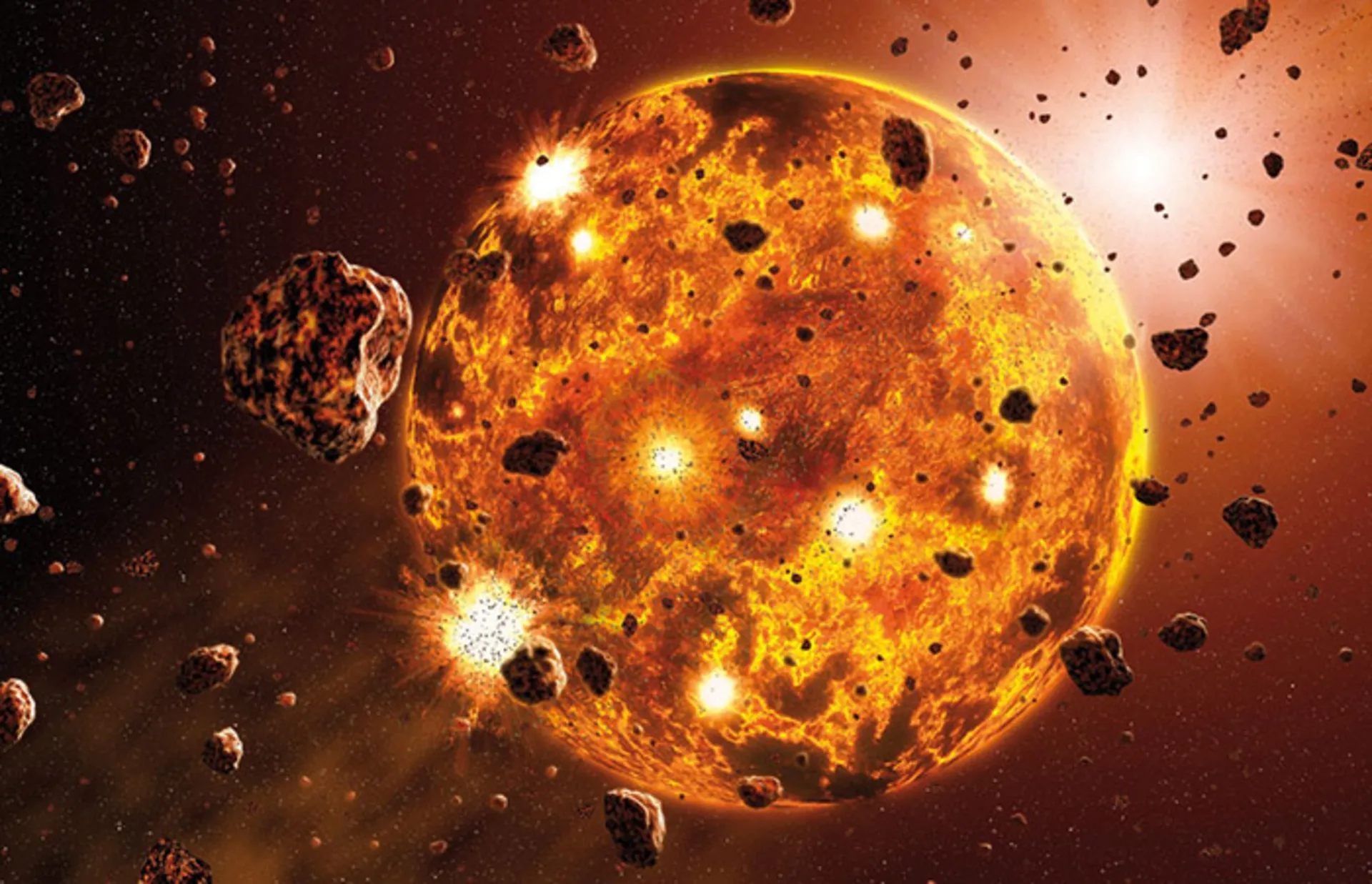
Disk instability model
However the need for a short time for the formation of gas giants is one of the problems of the core accretion model. According to the models, this process takes millions of years in the nuclear accumulation model. At the same time, the core accretion model also faces the problem of planetary migration, because small planets were placed in orbit around the Sun in a short period of time.
According to a relatively new theory known as disk instability, masses of gas and dust have joined each other in the early life of the solar system, and over time these masses have been compressed and formed gas giants. These planets are formed faster than their counterparts in the core accretion model, and their formation time even reaches several thousand years.
Saturn is how many times the size of Earth?
Saturn has 760 times the volume of Earth, it is the second heaviest planet in the entire solar system and has 95 times the mass of Earth. Saturn has the lowest density among the planets of the solar system. The density of this planet is even lower than water so if we drop Saturn in a large enough ocean, it will float on its surface.

Saturn accommodates 760 Earths
Physical characteristics and internal composition of the planet Saturn
Hydrogen and helium are the dominant elements of Saturn, hence this planet is a gas giant. Like Jupiter, Saturn does not have a defined surface, although it may have a solid core. The rotation of the planet Saturn has made the shape of this planet widen at the poles and rise at the equator.
According to standard planetary models, the internal structure of Saturn is similar to the internal structure of Jupiter; It means a rocky core in the center surrounded by hydrogen and helium. The composition of Saturn’s core is similar to Earth’s, but it is more dense. In 2004, scientists estimated the mass of Saturn’s core to be 9 to 22 times that of Earth. Saturn’s core is surrounded by a thick layer of liquid metallic hydrogen, after this layer there is a liquid layer of molecular hydrogen, which gradually enters the gas phase with increasing altitude. The outermost layer is located at an altitude of 1000 km and consists of gas.
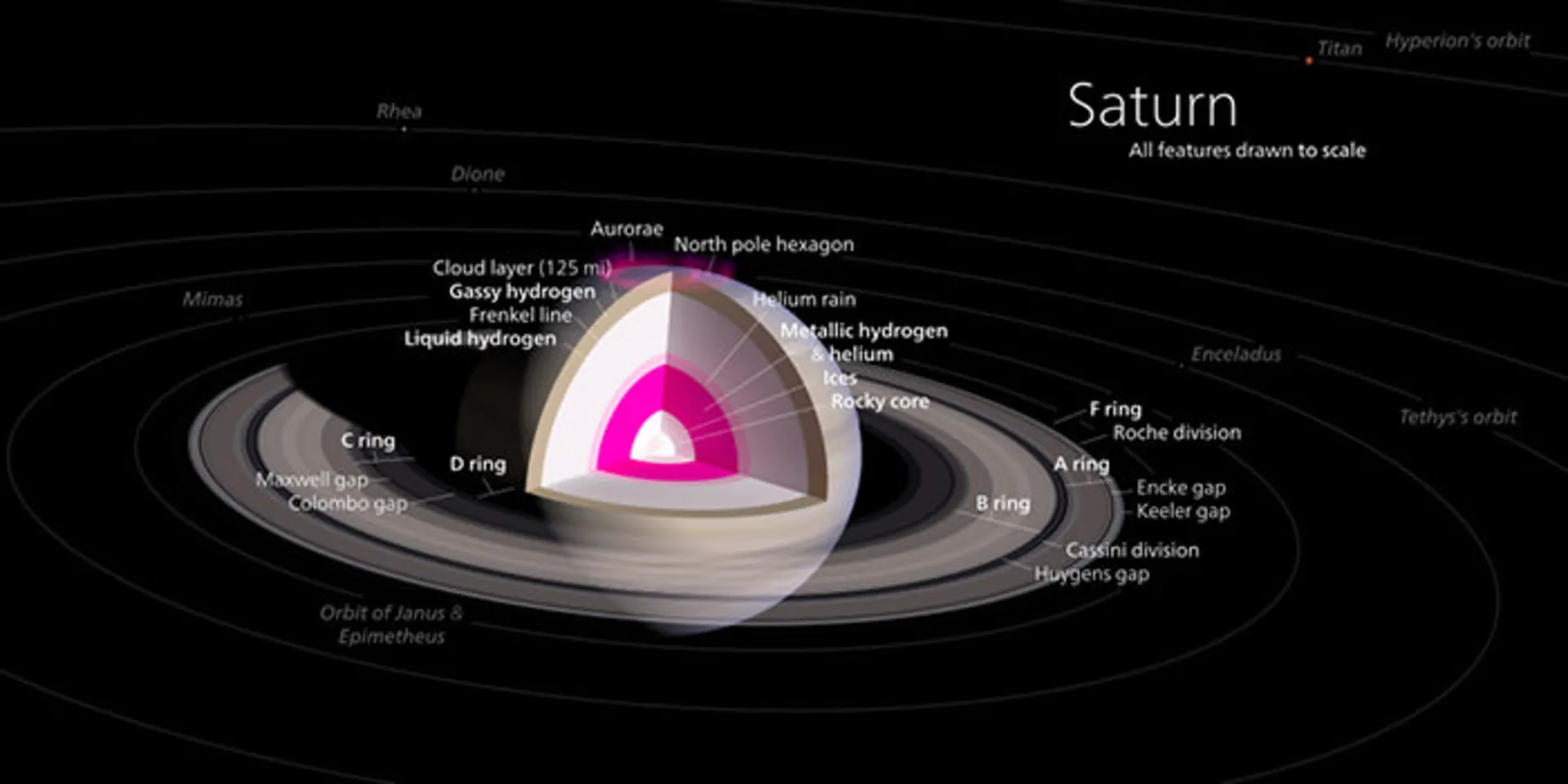
Composition diagram of Saturn: A layer of liquid hydrogen surrounds the core of this planet
The interior of Saturn is very hot and the temperature of its core reaches 11,700 degrees Celsius. Saturn releases 2.5 times the energy received from the Sun into space. Jupiter’s thermal energy is based on Kelvin Holmholtz’s slow gravitational compression mechanism (this mechanism occurs when the surface of a star or planet cools. The cooling process reduces the pressure and the star or planet shrinks), but this process is not sufficient to describe the heating of Saturn. . Another mechanism of heat production is the precipitation of helium droplets in the depths of Saturn. As the droplets fall on the low-density hydrogen, heat is released.
Saturn’s atmosphere and clouds
Saturn’s outer atmosphere contains 3.96% of molecular hydrogen and 25.3% of helium. In general, 75% of Saturn is hydrogen and 25% is helium and traces of other substances such as methane and frozen water can be found in its atmosphere. Amounts of ammonia, acetylene, ethane, propane, phosphine, and methane have also been discovered in Saturn’s atmosphere. The upper clouds are composed of crystalline ammonia, while the lower clouds are composed of ammonium hydrosulfide or water.
Although Saturn’s atmosphere is very similar to Jupiter’s, it appears uniform from a distance. Saturn’s atmosphere has a banded pattern similar to Jupiter’s. These bands become wider near the equator. The composition of clouds in different areas changes according to height and pressure increase. Saturn is one of the windiest places in the entire solar system and the wind speed in its equatorial regions reaches 1800 km/h. The yellow and gold bands in Saturn’s atmosphere are the result of super-fast winds in the planet’s upper atmosphere. Ultraviolet rays lead to the process of photolysis or photolysis in the upper atmosphere of Saturn, which leads to a series of hydrocarbon reactions. Saturn’s photochemical cycle also changes based on its seasonal cycle.
Saturn ranks second in terms of wind speed in the solar system
Saturn ranks second in terms of wind speed in the solar system after Neptune. Sometimes intense white storms disrupt the cloud layers. One of these storms was observed by the Hubble Space Telescope in 1994. To understand the characteristics of Saturn’s atmosphere, it is better to compare it with Earth. The atmosphere of Earth and Saturn have a major difference in terms of atmospheric pressure.
The radius of the planet Saturn is approximately 9 times the radius of the Earth, and the pressure increases as it penetrates into the deeper layers of the atmosphere. NASA’s observations of this planet show that the pressure of Saturn near the core is 1000 times the pressure on Earth, and this pressure is enough to convert hydrogen into liquid and then solid metal in the planet’s core. Atmospheric pressure levels common on Earth can only be found in the upper regions of Saturn’s atmosphere, where the ammonia ice clouds are located. The temperature of Saturn’s atmosphere varies from minus 130 degrees to plus 80 degrees Celsius.
Saturn’s magnetic field
Saturn has an internal magnetic field with a symmetrical and simple shape. Saturn’s magnetosphere is much smaller than Jupiter’s magnetosphere. The rings and many of Saturn’s moons are also within this magnetosphere, in this region the behavior of charged particles is more influenced by Saturn’s magnetic field than the solar wind.
The aurora phenomenon occurs when charged particles spiral in the planet’s atmosphere along the lines of the magnetic field. On Earth, these charged particles originate from the solar wind. Cassini showed that at least some of Saturn’s auroras are similar to Jupiter’s auroras and are not affected by the solar wind.
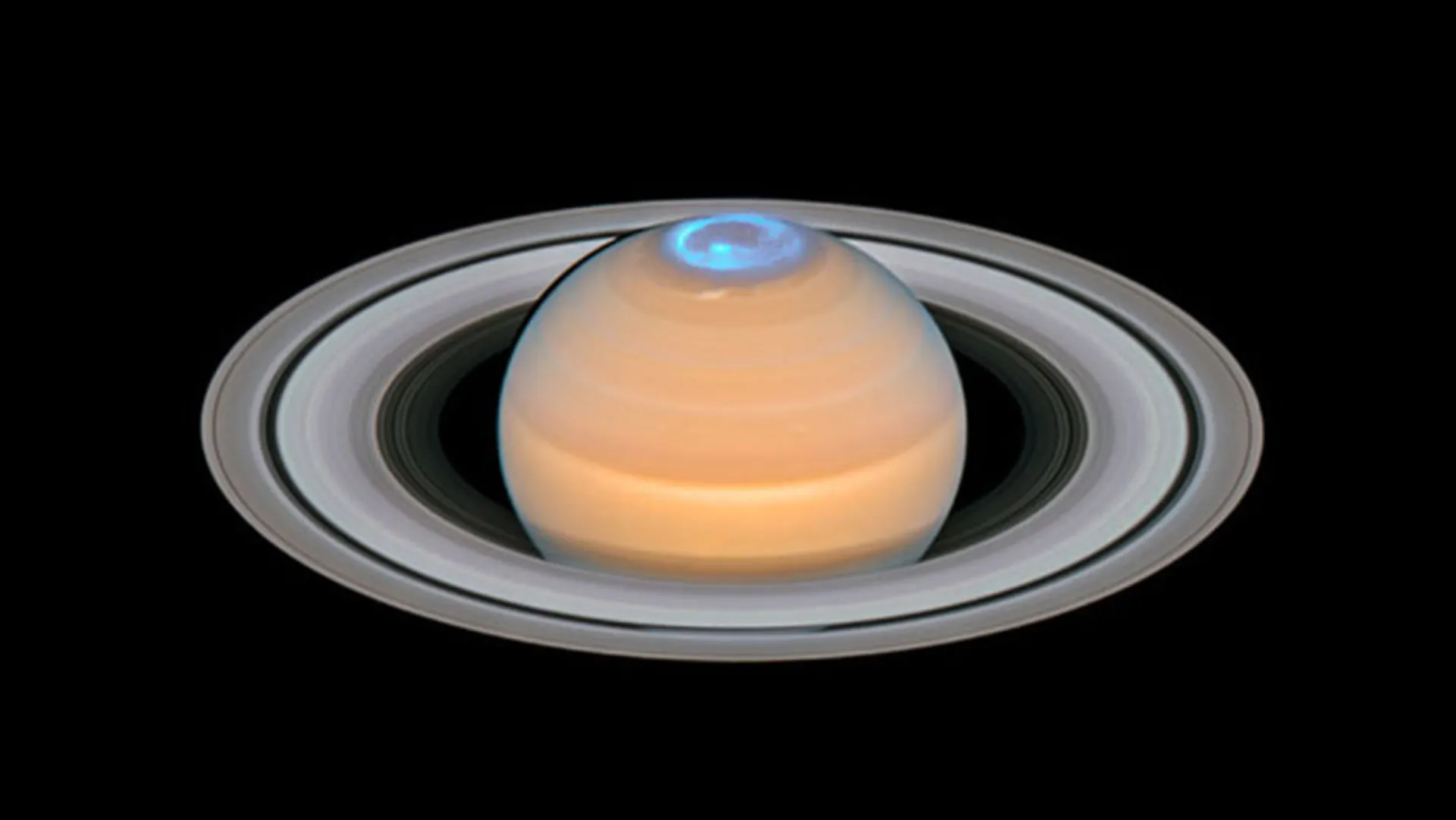
Saturn’s auroras are similar to Jupiter’s auroras
The orbit and rotation of Saturn
Compared to Earth, Saturn’s orbit around the Sun is slow, but its orbit around itself is faster. Saturn orbits the Sun at a speed of approximately 35,400 km/h. This speed is about one-third of the speed of the Earth’s movement around the sun. The length of Saturn’s year during a complete period of rotation around the Sun is equal to 29.5 years or 10,755 Earth days.
Although the movement of Saturn around the Sun is slow, its movement around its axis is much faster than that of the Earth, and it completes its rotation in less than half an Earth day. Because Saturn is about 10 times the diameter of Earth, any point on its equator moves 20 times faster than the corresponding point on Earth’s equator. This rapid rotation causes Saturn to form an oval shape so that it becomes flat at the poles and wide at the equator. Saturn’s day is equal to 10 hours and 38 minutes on Earth.
In 2007, it was found that the changes in radio emissions from Saturn do not correspond to its rotation speed. This variance may have occurred due to geyser activity on Saturn’s moon Enceladus. In this way, the water vapor released in the orbit of Saturn is charged and as a result, they cause stretching in the magnetic field of Saturn, and thus the rotation of the magnetic field becomes slower than the rotation of the planet itself.
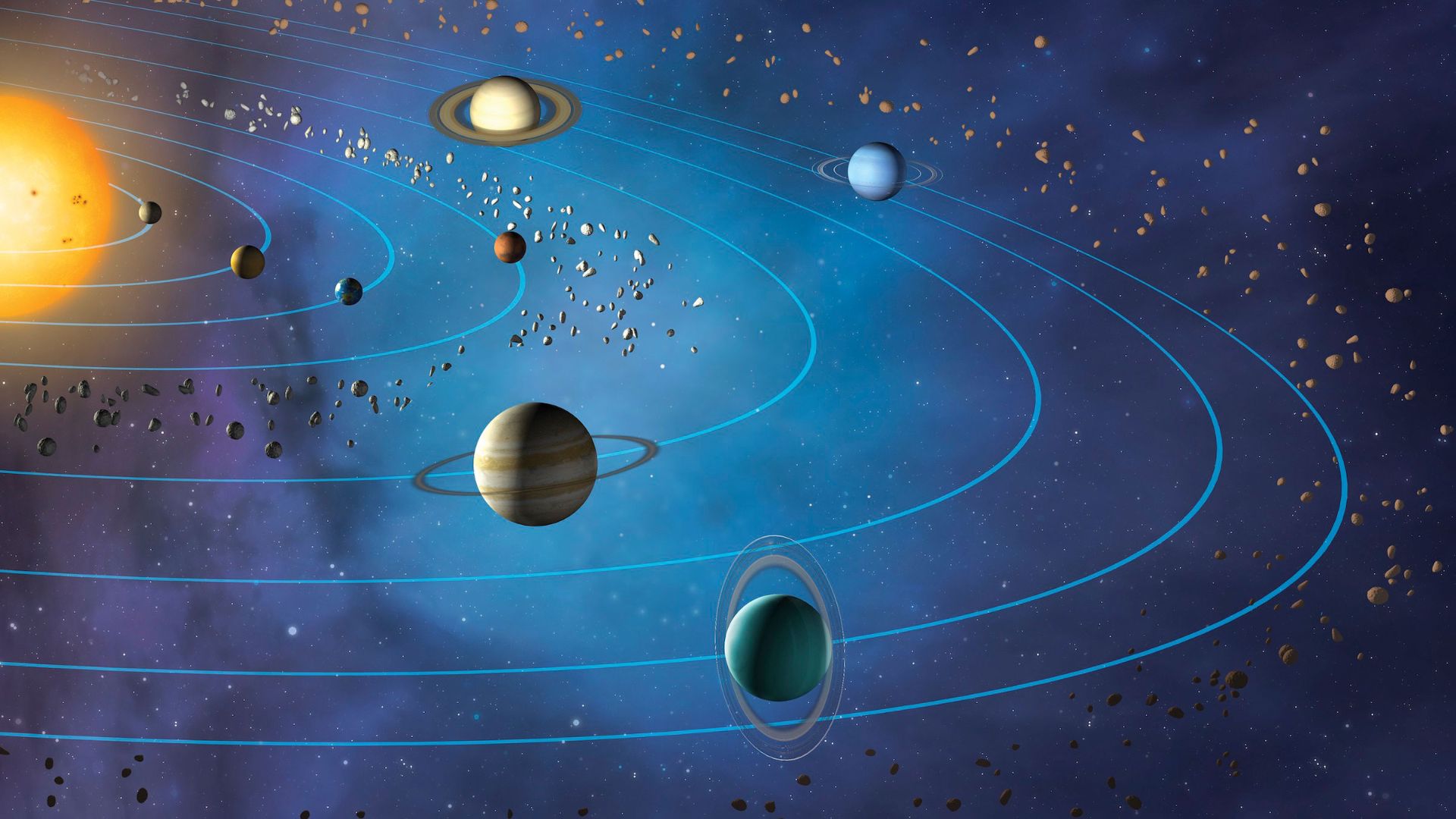
Rings of Saturn
Saturn’s prominent and bright rings make it a unique planet in the entire solar system. Saturn’s rings have fascinated astronomers for centuries. When Galileo first observed Saturn in 1610, he thought the rings were large moons on either side of the planet. During his seven years of observation and exploration, he recorded the rings changing shape and even disappearing (depending on the angle and declination with the Earth). ).
According to Galileo’s observations, Saturn’s equator has a 27-degree deviation from its orbit around the Sun (similar to the 23-degree deviation of the Earth). As Saturn revolves around the Sun, first one hemisphere and then the other hemisphere are facing the Sun. This deviation causes seasonal changes (similar to Earth) and when Saturn reaches the equinox, the equator and plane of the ring are aligned with the Sun. Sunlight hits the edges of the ring. The rings are generally 273,600 km wide, but only 10 meters thick.

In 1655, another astronomer, Christian Huygens, proved solid ring objects, and in 1660, another astronomer suggested that the rings were composed of satellites or small moons (a view that remained unconfirmed for 200 years).
In the modern era, Pioneer 11 passed through Saturn’s ring in 1979. In the 1980s, Voyager 1 and Voyager 2 investigated the planet’s ring system. In 2004, NASA’s Cassini Huygens mission became the first probe to enter Saturn’s orbit, recording detailed observations not only of the planet itself but of its ring system.
Saturn’s rings are made of billions of particles ranging from sand to large objects the size of mountains. Most of the particles are made of frozen water. When you look at Saturn with an amateur telescope, its ring appears to be one piece, but this ring is actually made up of several parts. The rings are named in order of discovery, so the main rings are named A, B, and C from farthest to closest. The width of the A gap is approximately 4700 km, which is also called the Cassini segment. This gap separates the A and B rings.
Other narrower rings were discovered as telescope technology improved. Voyager 1 discovered the innermost ring called D in 1980. The F ring is also placed outside the A ring. In contrast, the G and E rings are even further apart. The rings themselves are composed of a number of gaps and distinct structures. Some of them are very small moons of Saturn, while others confuse astronomers. Saturn is not the only planet in the solar system that has a ring system. Jupiter, Uranus, and Neptune also have rings, but Saturn’s ring is the most prominent type of ring.
There are different hypotheses about the formation of Saturn’s rings. Some scientists think that comets or passing meteorites are trapped by Saturn’s gravity and disintegrated before reaching it. The reason for the high brightness of Saturn’s rings is that a large part of the rings are made up of particles and ice pieces. The size of these particles varies from small pieces to large icebergs. These ice particles in Saturn’s rings form ice clusters and reflect a lot of light.
Another possibility suggests that the rings were once large moons orbiting the planet. Saturn has at least 83 moons. Only one of its moons, Titan, is a large moon. The rest of the moons are small objects and only 13 of them are more than 50 km. The gravity of these moons affects the structure of Saturn’s rings while providing clues about how the rings formed.
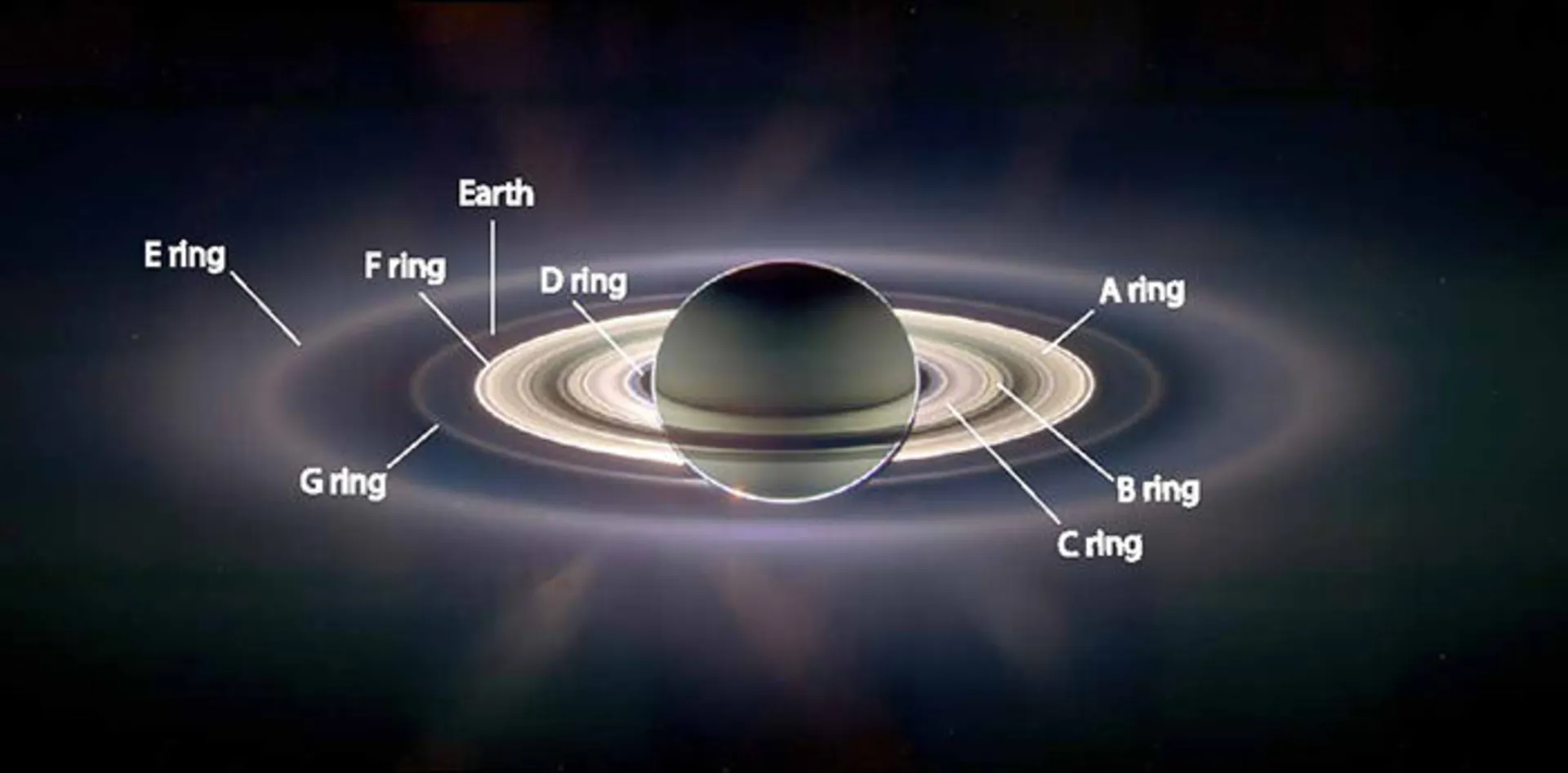
How many moons does Saturn have?
The planet Saturn has a large number of diverse moons, ranging from satellites with a diameter of tens of meters to large moons like Titan with dimensions larger than the planet Mercury. Saturn has 83 confirmed moons, only 13 of which have diameters greater than 50 km. Titan is the most prominent moon of Saturn and the second largest moon in the Solar System after Ganymede (Jupiter’s moon). The moon’s atmosphere, like Earth’s, is full of nitrogen and offers views of river networks and hydrocarbon lakes.
Twenty-four moons of Saturn are regular satellites and their progressive orbits are not inclined to Saturn’s equatorial plane. These twenty-four moons include seven main satellites, four small moons, two small co-orbiting moons, and two other moons that act as shepherds of Saturn’s F ring. The remaining 58 moons, which have a diameter varying from 4 to 213 km, are among the irregular moons whose orbits are at a greater distance from Saturn. These moons are probably trapped planets or parts of collapsed bodies after being trapped. Irregular moons are divided into Inuit, Norse, and Gaelic groups based on orbital characteristics. The names of these groups are taken from Greek mythology. The largest irregular moon Phoebe is the ninth moon of Saturn, which was discovered at the end of the 19th century. Saturn’s rings are a combination of microscopic variable bodies to satellites several hundreds of meters in diameter, each orbiting Saturn in its own orbit.
It is believed that the moon system of the planet Saturn was formed similar to the moons of the planet Jupiter, but in general, the details of the formation of the moons of Saturn are unclear. On June 23, 2014, NASA reported strong evidence that the nitrogen in Titan’s atmosphere came from material in the Oort Cloud, not from Saturn.
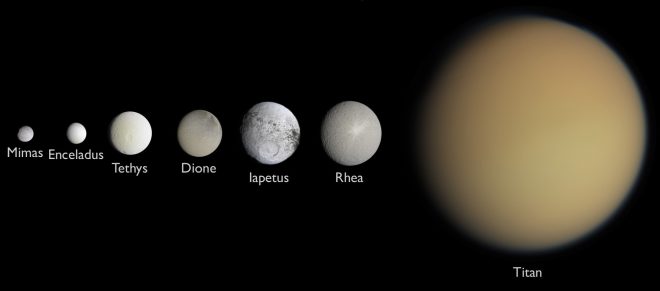

Comparison of Saturn’s moons in terms of size
Grouping of Saturn’s moons
Although the demarcation of Saturn’s moons is somewhat vague, they can be divided into ten groups based on their orbital characteristics. Many of these moons, including Penn and Daphnis, are in Saturn’s ring system, and their orbital period is slightly longer than that of Saturn. Inner moons and regular moons have an average orbital inclination ranging from 1° to 1.5°. On the other hand, the irregular moons in the outermost part of Saturn’s moon system, especially in the Norse group, have orbital radians of millions of kilometers and orbital periods of several years. The Norse moons also orbit Saturn in the opposite direction.
- Large inner moons: Saturn’s innermost large moons are located in Saturn’s thin E ring. These moons are Mimas, Enceladus, Tethys, and Dione.
- Large outer moons: These moons are located on the other side of the E ring, they are: Rhea, Titan, Hyperion, Iapetus
Irregular moons
Irregular moons are small satellites with high radians and inclinations and are thought to have been caught in Saturn’s gravitational trap in the past. The exact size of these moons is still unknown because their dimensions are so small that they are difficult to observe with a telescope.
Alkeonides
The three small moons between the moons of Mimas and Enceladus are called Alkeonids, which derives its name from Greek mythology. These three months are Matun, Ant, and Plan. Ant and Meton have a very thin circular arc in their orbit, while Plan has a completely thin ring. Among these moons, only Matun was photographed from a relatively close distance. This egg-shaped moon has a small number of impact craters.
Titan
Titan is the largest moon of Saturn and the second largest moon in the solar system (after Jupiter’s moon Ganymede). Titan is the only moon in the solar system with a dense and cloudy planet-like atmosphere. Scientists believe that the conditions on Titan are similar to the initial conditions on Earth, but the only difference is that the Earth is closer to the Sun and it is hotter. In many ways, Titan is the most similar to Earth.
Titan’s diameter reaches 2,575 km, which is almost 50% wider than the Earth’s moon. The distance between Titan and Saturn is about 1.2 million kilometers and 1.4 billion kilometers or 9.5 AU from the Sun. An astronomical unit is the distance from the Earth to the sun. It takes about 80 minutes for sunlight to reach Titan because of this distance, sunlight is about 100 times dimmer than sunlight on Earth.
It takes approximately 15 days and 22 hours for Titan to complete one orbit of Saturn. Titan is tidally locked to Saturn, which means that, like Earth’s moon, one side of it is always seen from Saturn. It takes approximately 29 Earth years for Saturn to complete an orbit around the Sun (Saturnian year) and Saturn’s axis of rotation, like Earth’s, has a deviation that creates seasons on this planet; But Saturn’s seasons are longer, typically lasting nearly seven Earth years each. Since Titan’s orbit is in line with Saturn’s equatorial plane and Titan’s deviation from the Sun is almost the same as Saturn’s, the seasons of this moon are the same as Saturn’s, that is, almost every season of Titan is seven Earth years and one year is equal to 29 Earth years.
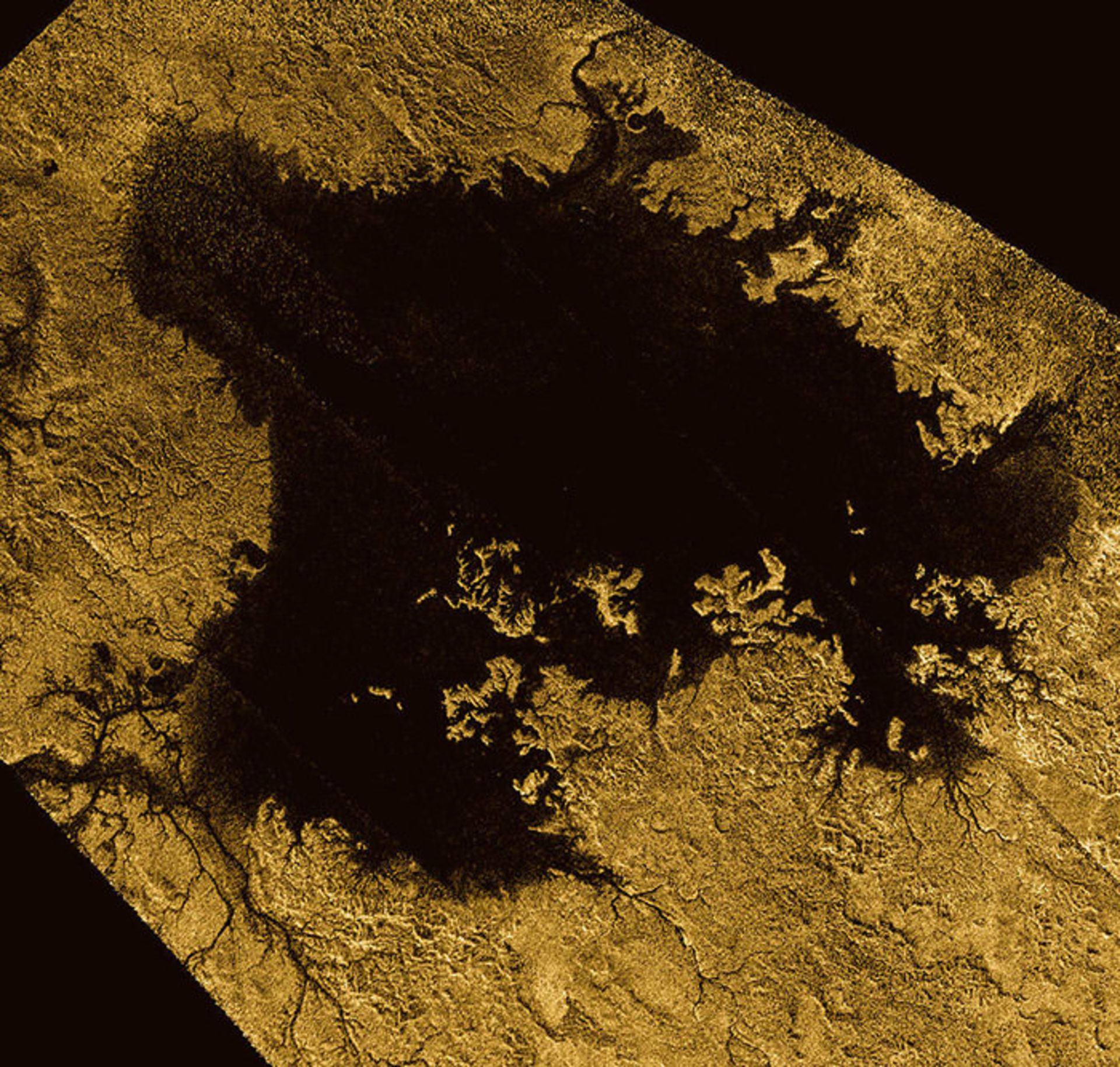
Cassini image of Titan’s north polar hydrocarbon lake
Scientists are not sure about the exact formation and origin of Titan. However, the atmosphere of this moon has clues. A number of Cassini Huygens probe instruments measured nitrogen-14 and nitrogen-15 isotopes in Titan’s atmosphere. According to the findings, the nitrogen isotope ratio found in Titan is very similar to the isotope of comets in the Everett cloud. The globular Oort cloud consists of hundreds of billions of icy bodies located between 5,000 and 100,000 AU from the Sun (each AU equals 150 million km). The nitrogen ratio of Titan’s atmosphere shows that the building blocks of this moon were formed in the same gas and dust cloud as the Sun in the early history of the solar system, and the origin of these blocks is not the hot disk of Saturn’s material.
Surface: Titan’s surface is one of the most similar to Earth in the entire solar system. Of course, its temperatures are lower and it has different chemical characteristics. The surface temperature of Titan reaches minus 179 degrees Celsius. Titan may also have volcanic activity. The surface of this moon is full of methane and ethane streams that form large river and lake channels. No other world in the entire solar system (except Earth) has surface liquid.
Titan’s rains are made of methane and form the moon’s seas and lakes
Atmosphere: Nearly 95% of Titan’s atmosphere is nitrogen and 5% is methane. Traces of carbon compounds can also be found in the atmosphere of this planet. At the heights of this moon, methane and nitrogen molecules are decomposed due to the impact of the ultraviolet light of the sun and energetic particles. Parts of this molecule are recombined and produce various biological chemicals such as materials containing carbon, hydrogen, nitrogen, oxygen, and other essential elements for life.
Some of the compounds are formed by decomposition and cycle of methane and nitrogen. Methane and nitrogen create a thick, orange cloud that covers the surface of this moon, which is why it is difficult to examine Titan’s surface from space. The origin of all the methane in the atmosphere still remains a mystery.

The presence of methane and nitrogen in Titan’s atmosphere causes orange clouds
The potential for life on Titan
Cassini’s numerous gravity measurements of Titan suggest that the moon has a subsurface ocean of liquid water, possibly mixed with salt and ammonia. The European Space Agency’s Huygens probe also measured radio signals from the moon’s surface in 2005, indicating oceans 55 to 80 kilometers below Titan’s icy surface. The discovery of a global ocean of liquid water also places Titan in the group of moons of the solar system that have the potential for life. In addition to these rivers, lakes, and seas of methane and liquid ethane on the surface of Titan, they could act as a habitable environment on the surface of this moon, although any possible life on this moon would be different from terrestrial life; Therefore, Titan can host habitats and suitable conditions for life, including life that we know (in the subsurface ocean) and life that we do not know (in surface hydrocarbon liquids). Although evidence of life on Titan’s surface has yet to be discovered, the moon’s complex and unique chemical nature are definitive findings that make it an ideal destination for exploration.
Enceladus
Few moons in the solar system are as fascinating as Enceladus. Some of these moons are thought to have oceans of liquid water beneath their frozen crusts, but one of the unique features of Enceladus is its glaciers. Based on samples obtained from space probes, Enceladus has the most chemical elements necessary for life and probably has hydrothermal or hydrothermal vents that transport hot mineral water from subsurface oceans.
About the size of Arizona, Enceladus has the whitest and most reflective surface in the Solar System. This moon has a ring system and releases ice fragments into its orbit in space. These fragments form Saturn’s E ring. The name Enceladus comes from Greek mythology. The images of the Voyager spacecraft in the 1980s show that this moon, despite its small size (approximately 500 km in diameter), has a relatively smooth ice surface in some places and has a high brightness. In fact, Enceladus is one of the most reflective bodies in the solar system, the reason for which scientists did not know for years.
Since Enceladus reflects a large part of the sunlight, its surface temperature is extremely low and reaches minus 201 degrees Celsius. Enceladus is located at a distance of 238 thousand kilometers from Saturn between the orbits of two other moons, Mimas and Tethys. The moon is tidally locked to Saturn, taking approximately 32.9 hours to complete one orbit in the densest part of Saturn’s E ring.
In 2005, NASA’s Cassini spacecraft revealed water ice, and gas particles ejected from the surface of Enceladus at speeds of approximately 400 meters per second. These eruptions appear to be continuous, creating a huge halo of icy dust around Enceladus that forms the material of Saturn’s E ring. Only a small fraction of this material enters the ring, and most of it falls on the surface of Enceladus as snow. For this reason, this moon has a white and bright surface.
Enceladus’ glaciers originate from relatively warm cracks in its crust, which scientists call tiger stripes. Several gases such as water vapor, carbon dioxide, methane, and maybe a little ammonia, carbon monoxide, and nitrogen along with salt and silica make up the gas cover of Enceladus’ glacial channels. The density of biological material in glaciers is twenty times higher than expected by scientists.
Based on measurements of the Doppler effect and the very small amplitude of Enceladus’ wobble as it spins around, scientists have discovered a global ocean beneath the moon’s surface. They believe that the thickness of the ice shell of Enceladus in its south pole is close to 1 to 5 km. The average thickness of the entire crust is between 20 and 25 km.
Since the ocean of Enceladus has ice, and the glaciers form Saturn’s E ring, examining the E ring could mean examining the ocean of Enceladus. A large part of the E ring is made up of ice particles, but among them you can also find very small particles of silica. These particles are formed when liquid water and rock react with each other at temperatures above 90 degrees Celsius. This is another indication of the existence of warm blue channels under the icy crust of Enceladus, which are not dissimilar to the warm blue channels of the Earth’s oceans. Enceladus is one of the prime candidates for life in the solar system with features such as a global ocean, unique chemistry and internal heat.
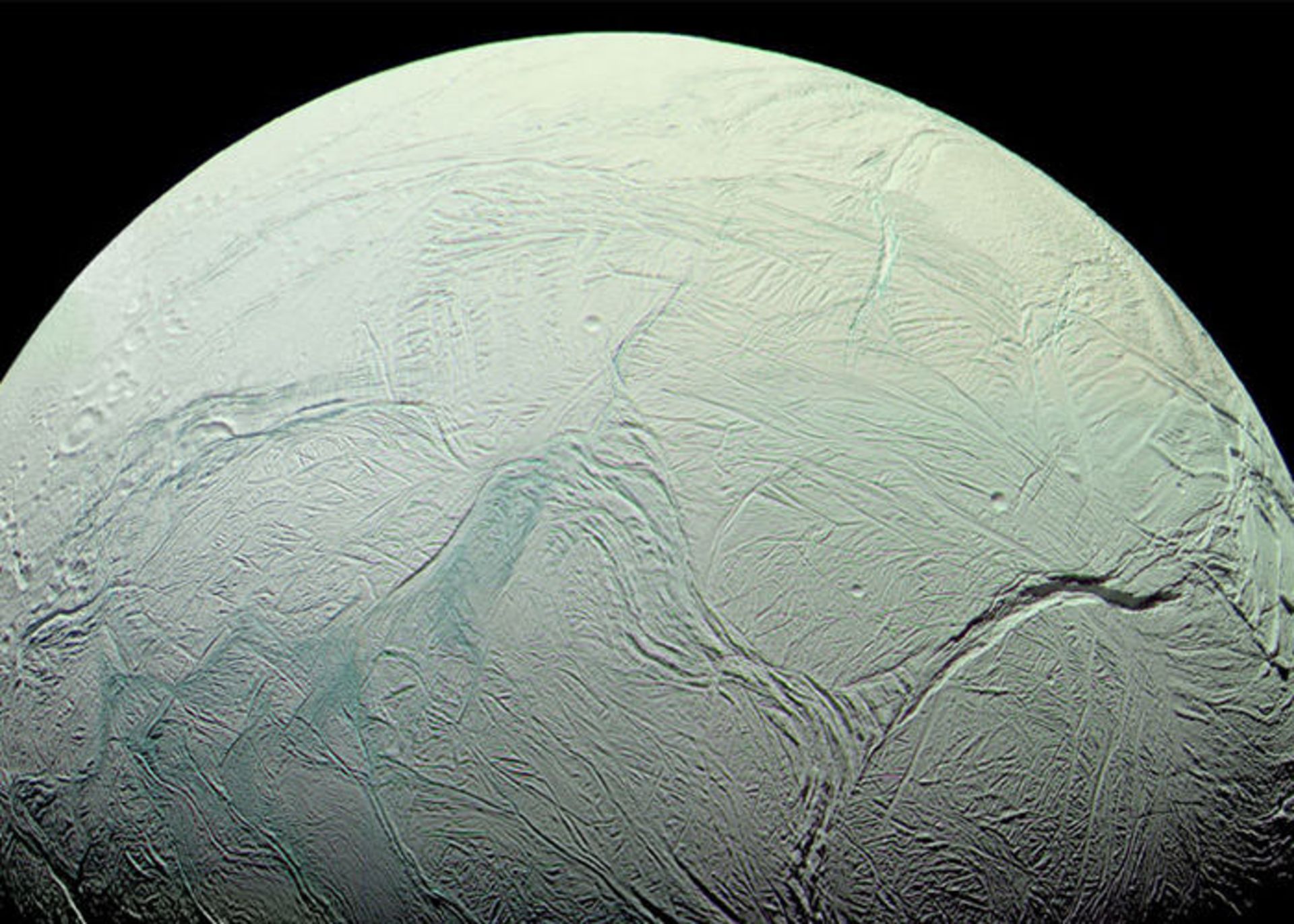
Iapetus
Iapetus is the third largest moon of Saturn and the eleventh largest moon in the entire solar system. The young Cassini discovered this moon on October 25, 1671. However, Iapetus was seen by astronomers as a point whose brightness changed during Saturn’s orbital period. Voyager 1 and 2 probes visited the Saturn system and this moon in the 1980s and revealed its strange features. The diameter of the Iapetus reaches 736 km. Like Rhea, three-fourths of Iapetus, the other moon of Saturn, is made of ice, and one-fourth of it is made of rock.
According to the two claims of Iapetus, Saturn’s moon is included in the list of strange moons of the solar system. This moon was discovered in 1671 and one side is dimmer than the other side. The part of the hemisphere facing Saturn’s orbit is dark brown in color; while the other hemisphere is light gray. According to a theory explaining the color difference of this moon, the side facing Saturn is covered with dust that was spread by small meteorite impacts on other small outer moons of Saturn.
Meanwhile, the Cassini images tell a more complicated story. Most of the dark material on the surface of Iapetus originates from inside this moon and leaves behind dark streaks by the sublimation of dusty ice from the moon’s surface (solid to vapor). This process probably begins with the accretion of dust from exoplanets.
Also, Iapetus has a mountain range 13 km high and 20 km wide at the equator, which gives it a distinctive walnut-like appearance. The origin of this mountain range is unknown. According to some theories, this mountain is a fossil from the time of the faster rotation of Iaptus, which arose in the equatorial part; While others believe that this mountain is the result of pebbles from the ancient ring system around this moon that collapsed and landed on the surface.

Hyperion
Hyperion is the largest non-spherical irregular moon of Saturn. Its average radius is 135 km, but since this moon is potato-shaped, its shape can be described based on its diameter along three axes. Hyperion has a strange appearance: its surface is like a sponge or coral with dark pits and sharp grooves formed by ice and lighter rocks. However, this is not the only strange feature of Hyperion: Hyperion was the first discovered non-spherical moon and has an eccentric orbit.
Hyperion’s rotation does not coincide with its orbital period and orbits Saturn in an irregular pattern; so that its rotation axis fluctuates unpredictably. Like other moons of the solar system, Hyperion is made of water ice; But its surface is strangely dark. According to Cassini spacecraft estimates, the density of Hyperion is 55% of that of water; As a result, a large part of its interior is empty.
According to a popular theory, one of the reasons for Hyperion’s strange properties is that it was a remnant of a larger moon that was probably located between Titan and Iapetus and was destroyed by a collision with a large comet. The remaining material condensed again and formed Hyperion.
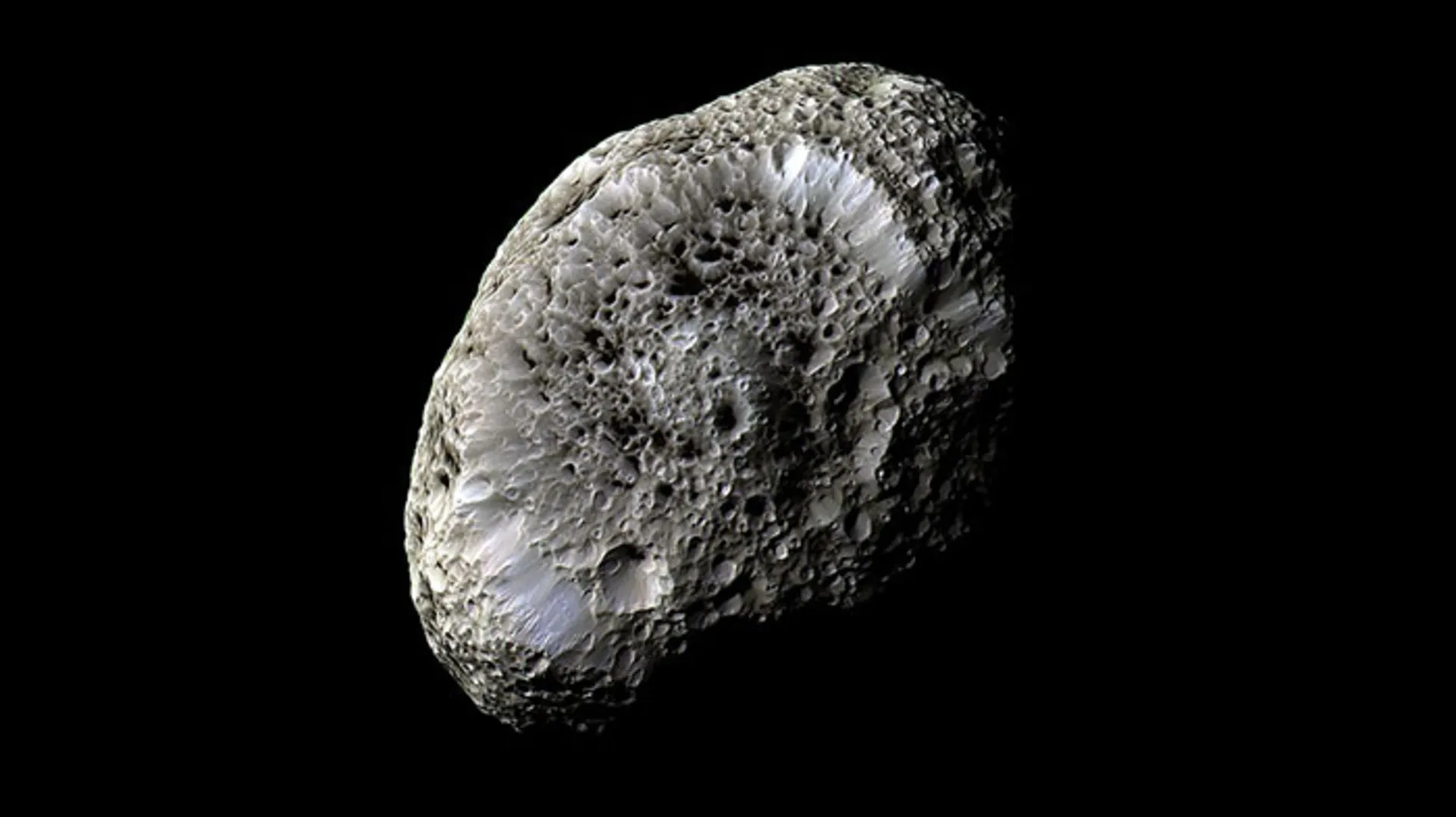
Mimas
The Voyager probes shocked scientists by capturing detailed images of Saturn’s moon Mimas in the 1980s. This moon is very similar to the Death Star in the sci-fi movie Star Wars. A large impact crater covers one of the hemispheres of this moon and is exactly the same size and similar to the destructive laser plate that George Lucas mentioned; But Mimas is more than just an element of popular culture.
Mimas is Saturn’s innermost moon, orbiting closer to Saturn than Enceladus and farther than Pan and Atlas. The diameter of this moon reaches 396 km; For this reason, the smallest object in the solar system is spherical in shape.
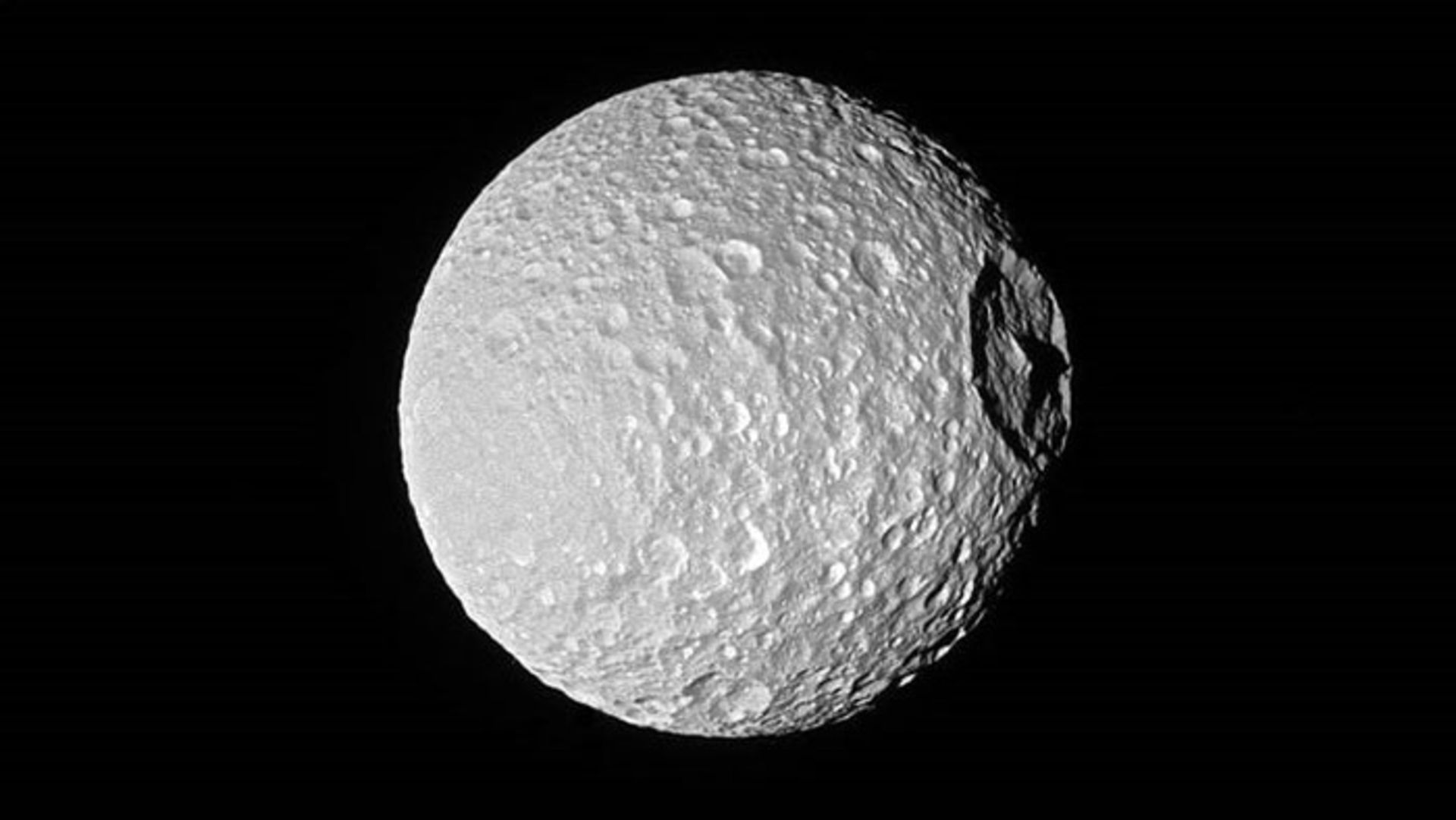
Herschel impact crater on the surface of Mimas. The name of this impact crater is derived from the name of William Herschel, who discovered this moon in 1789.
Pan and Atlas
Pan and Atlas are both Saturn’s innermost moons. Atlas orbits Saturn at the outer edge of the A ring. It takes approximately 14.4 hours for Atlas to complete one orbit of Saturn, and 8.13 hours for Pan. Saturn’s moons Pan and Atlas are the smallest moons in the solar system. Despite their small size, these moons can influence Saturn’s ring system. These small worlds are perhaps the best-known examples of shepherd moons. Shepherd moons are small moons that are located in the ring systems of giant planets. As their name suggests, these moons help particles in the Saturn system stick together, while also cleaning up other particles.
Pan causes Encke Gap; A prominent resolution is seen in the bright ring A; While Atlas is located outside the ring A. The most important feature of both moons is their smooth surface, which looks like a flying saucer or a walnut. Bonnie Borrati of NASA’s Jet Propulsion Experiment believes these moons are covered in tiny particles that clear the space between the rings.

Pan and Atlas in the shape of a flying saucer
Rhea
Rhea is the second largest moon of Saturn, but its average radius is one-third that of Titan, Saturn’s largest moon. Rhea is a small, cold and airless world that is very similar to its moons, Dione and Tethys. Like the other two moons, Rhea has a tidal lock to Saturn, which means that one side of it is always seen from Saturn. It takes 4.5 Earth days for Rhea to complete one orbit of Saturn. The surface temperature of Rhea is similar to that of Dion and Tethys, which reaches minus 174 degrees Celsius in sunny areas and minus 220 degrees Celsius in shadow areas. Rhea, like Dion and Tethys, has a high reflectivity and shows that its surface is mainly composed of water ice.
Rhea is located at a distance of 527,000 km from Saturn and is a bit further from Dione and Tethys. In 2010, the Cassini spacecraft discovered a very thin atmosphere called the exosphere around Rhea, which is a mixture of oxygen and carbon dioxide. Cassini also detected signs of material in Rhea’s orbit in 2008. This was the first discovery of a ring around a moon.
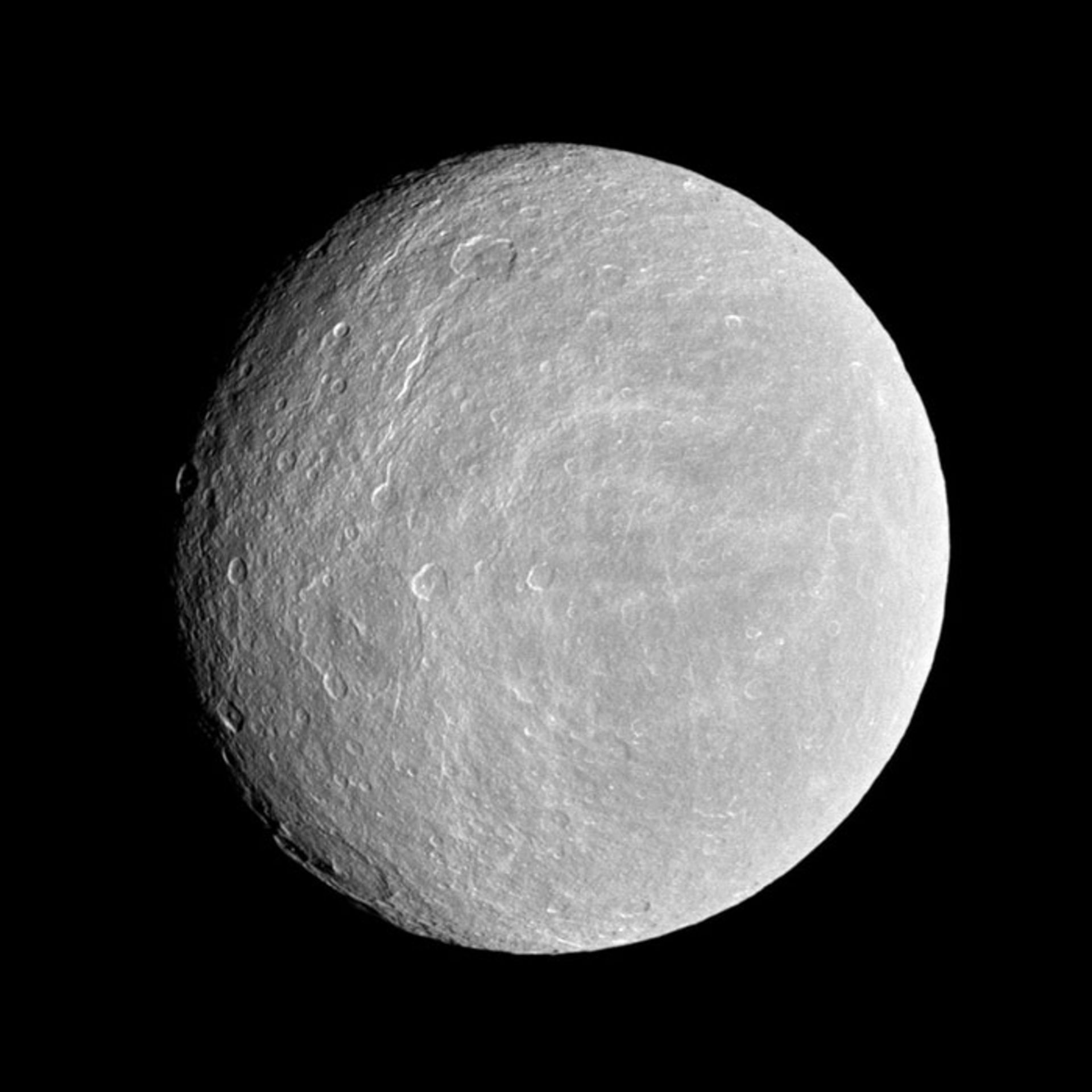
Dione is a small moon with an average radius of 562 km that completes the orbit of Saturn once every 2.7 days. This moon is located at a distance of 377 thousand kilometers from Saturn, which is exactly equal to the distance between the moon and the Earth. The density of dione is 1.48 times that of liquid water, as a result, one-third of dione is made up of a dense core (probably of silicate rock), and the rest is made of ice.
Very fine icy powders (similar to smoke) from Saturn’s E ring bombard the surface of Dione. The E ring dust is formed from the icy moon Enceladus. The surface of Dion is full of impact craters so that the diameter of the craters reaches 100 km.
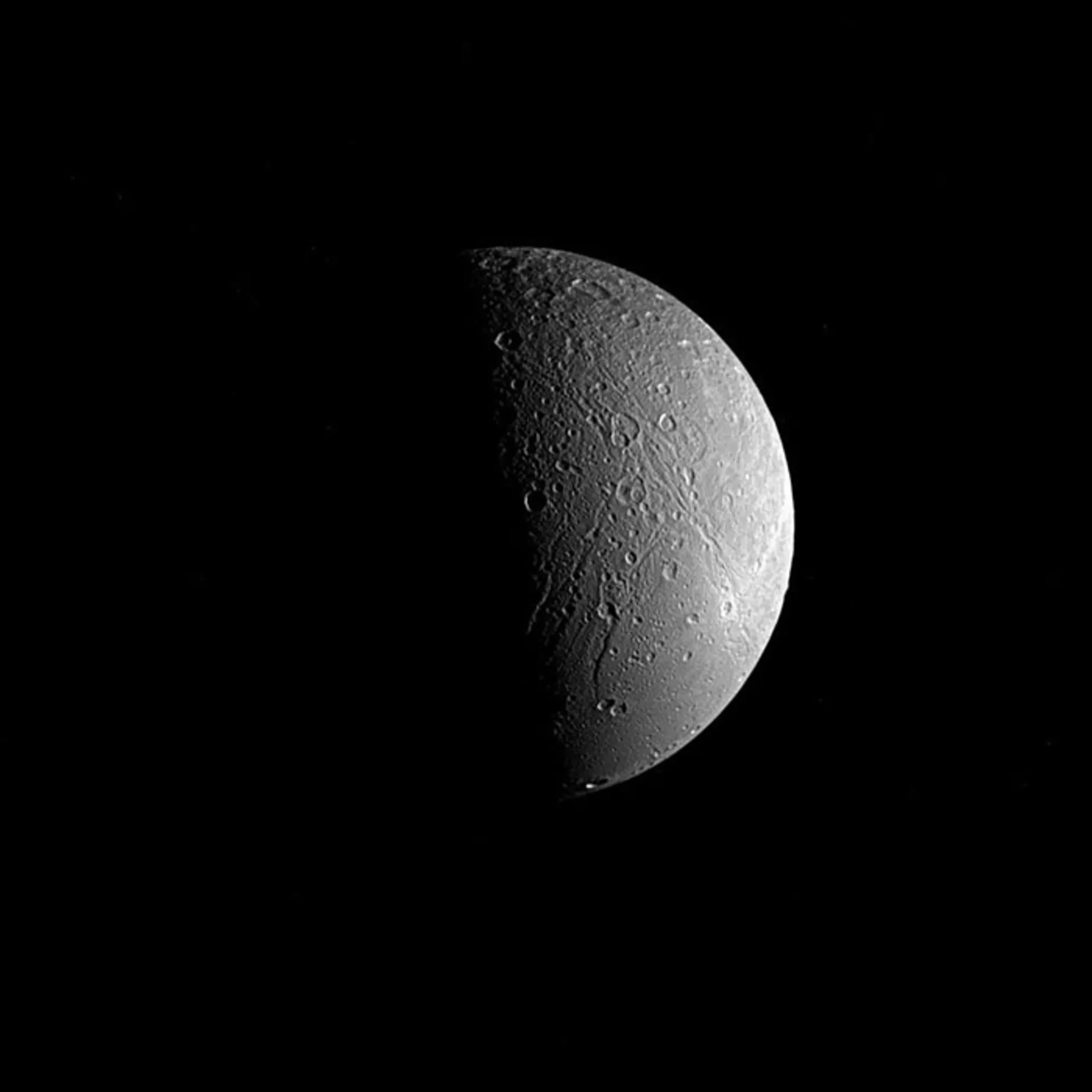
Tethys
Tethys is the fifth largest moon of Saturn. Its average radius reaches 633 km. This cold and airless moon is very similar to its sister moons, Dione and Rhea. Of course, with the exception that Tethys does not have many impact craters like the other two moons. A large part of Tethys is made up of water ice and a small part of it is made up of rock.
Tethys has a high reflectivity and this feature is another indication of its ice composition. The average temperature of Tethys reaches minus 187 degrees Celsius. Tethys appears as a small dot in the night sky, and its true nature was revealed after a visit by the Voyager probes. It takes 3.45 hours for Tethys to complete the orbit of Saturn.

The wonders of the planet Saturn
Hexagonal Storm: Saturn’s north pole has a fascinating feature called a hexagonal wind flow. This hexagonal pattern was first observed from images sent by the Voyager spacecraft and then observed from a closer distance by Cassini. This hexagon, whose diameter reaches 30,000 km, is a wavy current, whose wind speed reaches 322 km/h, and a storm is placed in its center. This storm is unique in the entire solar system. At the south pole of Saturn, there is also evidence of storm currents, but no hexagonal waves are seen. According to NASA reports from Cassini in November 2006, a tornado-like storm was observed at Saturn’s south pole.
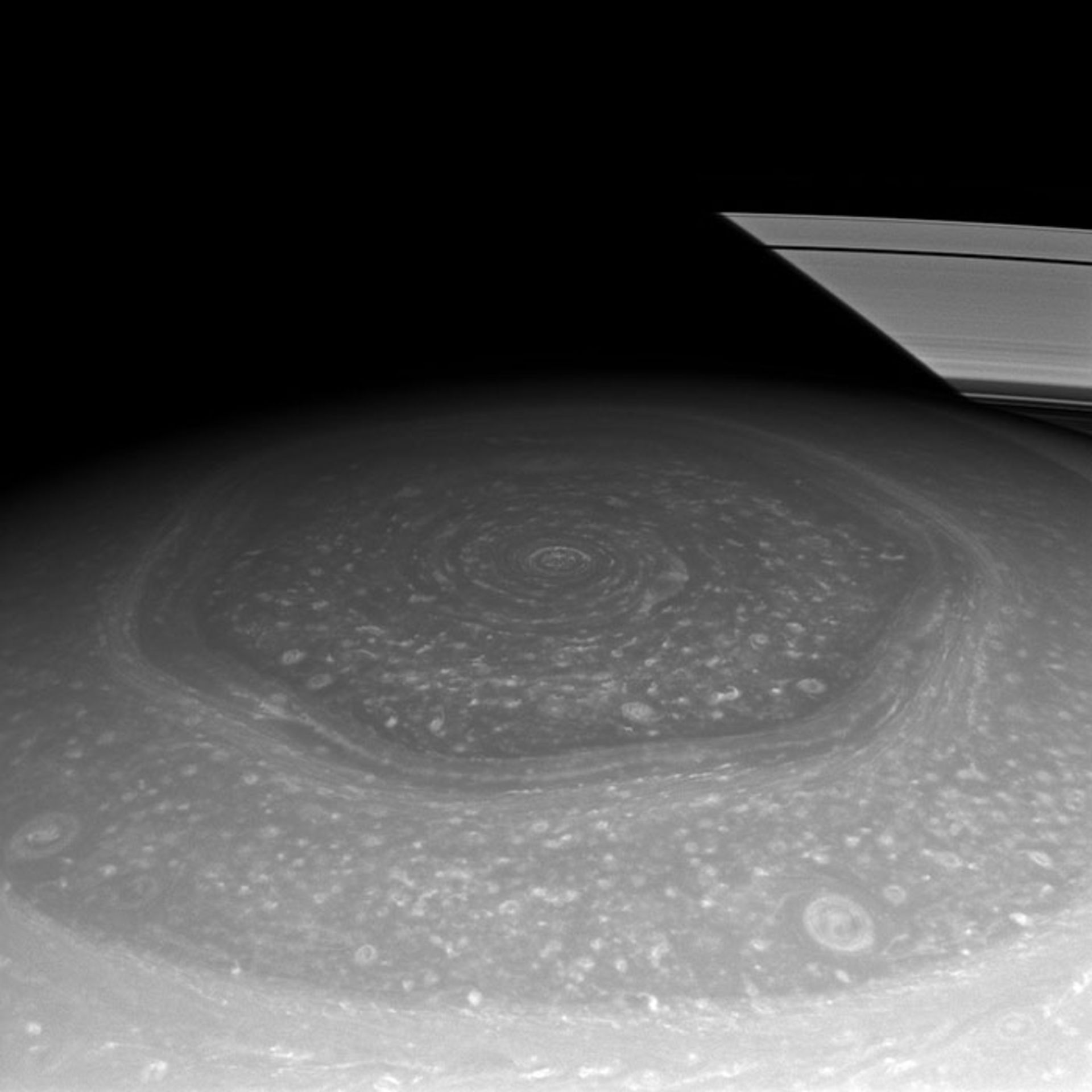
Reduction of rings: According to NASA research, Saturn’s rings have been decreasing at a maximum speed since Voyager probes visited this planet. These rings were attracted towards this planet due to gravity and under the influence of Saturn’s magnetic field. According to scientists, Saturn’s rings will be completely destroyed in three hundred million years, on the other hand, according to Cassini’s findings, Saturn’s rings are relatively young and their life is less than one hundred million years. As a result, the rings of Saturn are much younger compared to the life of this planet (4 billion years).
Long seasons: Saturn has seasonal changes like Earth, but Saturn’s seasons have a major difference from Earth’s seasons. It takes one year for the Earth to complete the orbit of the sun, during this time the Earth experiences cold and hot seasons. But since Saturn is far from the Sun, it takes 29 Earth years to complete the orbit of the Sun. As a result, one Saturn year is equal to 29 Earth years. Therefore, the seasons also get longer and the duration of each Saturnian season is approximately seven years.
Diamond rain: Since the internal structure of Saturn is completely different from the structure of Earth, its rains are not made of water but of diamonds. According to scientists, ten million tons of diamonds are produced in Saturn’s atmosphere every year. This phenomenon occurs thanks to the combination of methane gas (CH4) with the wind activities of this planet. Saturn’s rays have a high temperature and are 10,000 times stronger than Earth’s rays, and when they are emitted, they break molecular bonds and separate hydrogen and carbon.
Ten million tons of diamond rain falls on Saturn every year
The carbon atoms join together to form larger molecules that result in a soot-like compound. This black cloud is far from a diamond, but the story does not end there. The new molecule is relatively heavy and will fall down when caught in the planet’s gravity trap. By falling to greater depths, the temperature and pressure on the molecules also increase. These conditions lead to carbon transformation. At first, carbon is converted to graphite. The same stuff that’s inside your pencils and then turns into one-centimeter-diameter diamonds and they keep falling.
Seeing Saturn from Earth
The observation and exploration of Saturn can be divided into three phases. The first period of ancient observations (including observations with the naked eye) is before the invention of the telescope. Advanced ground-based telescopic observations began in the 17th century. According to written history, the planet Saturn has been one of the main elements of many myths. Babylonian astronomers systematically observed and recorded the movements of Saturn.
The third phase was the visit of space probes, simultaneously with this period of ground-based observations (including the Hubble Space Telescope) continued. To see Saturn’s rings, you need a telescope with a diameter of at least 15 mm. Christian Huygens was able to achieve this success in 1659. Before that, Galileo had observed Saturn with his early telescope and thought that Saturn was not completely spherical. Until Huygens was able to observe Saturn’s rings for the first time with a more advanced telescope. Huygens also discovered Titan, Saturn’s largest moon. Later, the young Domenico Cassini discovered four more moons of Saturn: Iapetus, Rhea, Tethys, and Dione.
William Herschel discovered two other moons, Mimas and Enceladus, in 1789. A British team also discovered Hyperion in 1848. William Henry Pickering discovered Phoebe in 1899, which is an irregular moon that does not rotate perfectly in sync with Saturn and its other moons. In the 20th century, studies of Titan proved the existence of a thick atmosphere on this moon.
Discoveries of Saturn in the Space Age
In the modern era, Hubble Space Telescope observations continued. Pioneer 11 was the first spacecraft to observe Saturn from a close distance, later Voyager 1 and 2 provided more detailed observations. But Cassini was the only orbiter that provided more detailed and comprehensive information about Saturn, and the Huygens probe of this spacecraft landed on the surface of Titan for the first time in 2005.
Pioneer discoveries 11
Pioneer 11 passed through the upper clouds of Saturn for the first time in September 1979. Pioneer 11 photographed Saturn and several of its moons, although the quality of the images is low and does not show much detail. The spacecraft also examined Saturn’s rings and revealed the thin F ring.
Pioneer 11 also showed that dark gaps in Saturn’s rings appear bright and contain light-scattering material when viewed from a high phase angle (towards the Sun). Another achievement of Pioneer in the exploration of Saturn was to measure the temperature of Titan.
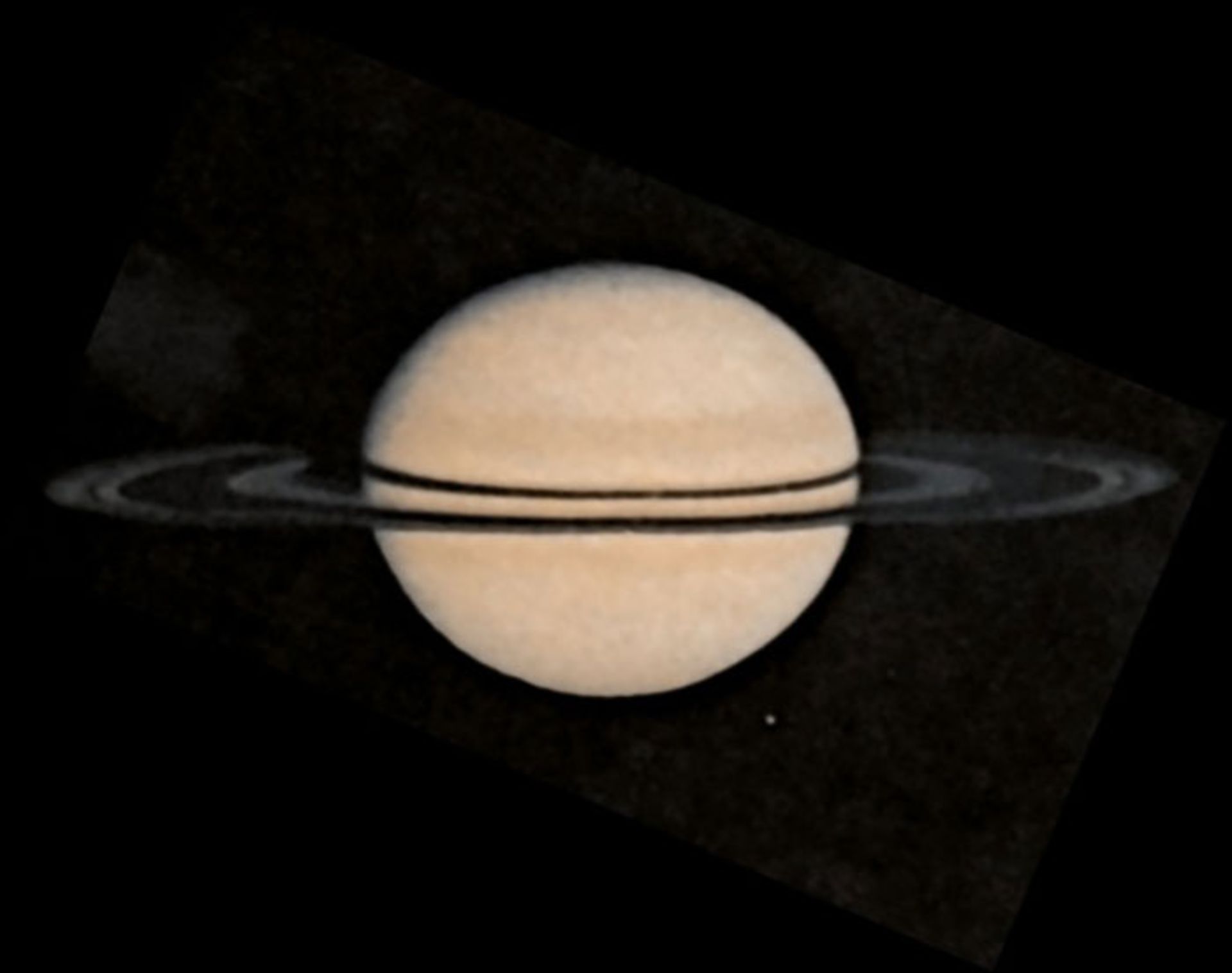
Pioneer 11 low quality image of Saturn
Voyager 1 and 2 discoveries
Voyager 1 visited the Saturn system in November 1980. The probe released the first high-quality images of the planet, its rings, and its moons. The surface features of Saturn’s moons were first revealed by Voyager. Voyager 1 approached the moon Titan and sent back a lot of information about the moon’s atmosphere. According to the data of this probe, Titan’s atmosphere is impenetrable in visible wavelengths, as a result, none of its surface details were seen.
Almost a year later, in August 1981, Voyager 2 continued its survey of the Saturn system. More detailed images of Saturn’s moons were sent, as well as evidence of atmospheric changes and its rings. Unfortunately, the probe’s rotatable camera malfunctioned for several days during the Saturn survey, and many views were not recorded. Operators used Saturn’s gravity to redirect the spacecraft toward Uranus. The two Voyager probes discovered a number of moons near and inside Saturn’s rings, as well as the small Maxwell fissure (a gap in the C ring) and the Keeler fissure (a wide, 42 km gap in the A ring).
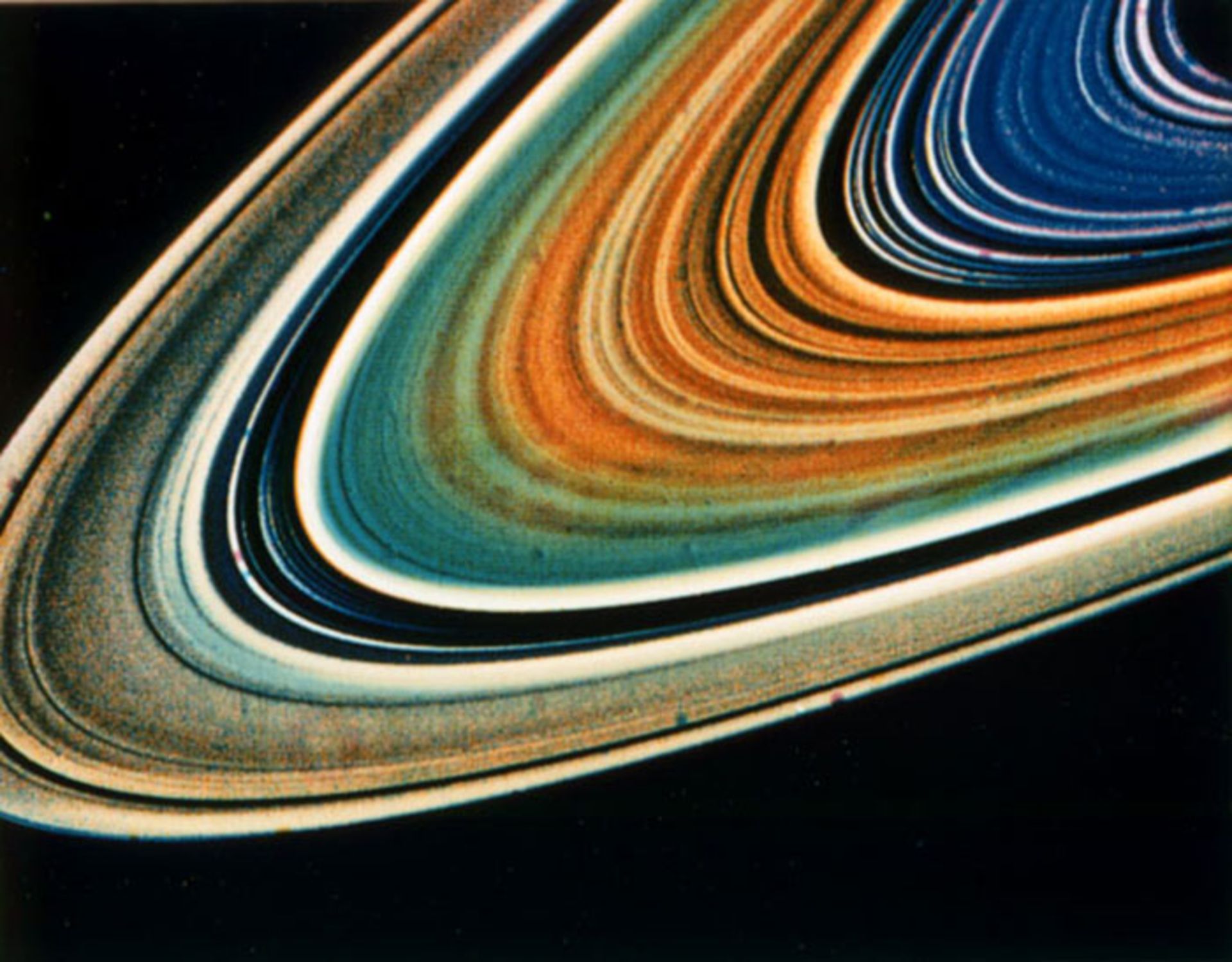
Image captured by Voyager 2
Cassini Huygens: Exploring the Saturn System
The Cassini spacecraft began orbiting Saturn on June 30, 2004 and continued its mission until September 15, 2017, when the probe ended its life by hitting the planet’s atmosphere. The destruction of Cassini was intentional and to ensure that the moons Enceladus and Titan were not contaminated. Cassini’s achievements include the discovery of the glaciers of Enceladus and the discovery of new moons for Saturn. Cassini was a joint project of multiple space agencies and was pitted against NASA’s older and larger probes, including Pioneer and Voyager. Cassini’s partners were NASA, the European Space Agency, and the Italian Space Agency.
Cassini was the first spacecraft dedicated entirely to studying Saturn and its ring system. The orbiter was named after Giovanni Cassini, an astronomer of the 17th century. Cassini was not launched directly at Saturn. Rather, its mission was a little more complicated. Before reaching Saturn, he checked the planets Venus (twice), Earth, and Jupiter and thus used the gravity of each planet to increase his speed. This 5700 kg spacecraft was launched on October 15, 1997. It reached Venus in April 1998, Earth in August 1999, and Jupiter in December 2000.
Cassini finally entered Saturn’s orbit on July 1, 2004. One of the main goals of this mission was to discover more moons for Saturn and to discover the structure and color of the rings, as well as to get more information about the moons of this planet. Cassini carried a passenger called the Huygens probe. Huygens landed on the surface of Titan on January 14, 2005, and transmitted data to Earth for 2.5 hours.
In this short period of time, the researchers obtained images of the surface as well as information about the gases and winds in the atmosphere and on the surface of Titan. Cassini discovered two new moons for Saturn and discovered the presence of liquid water on the surface of Enceladus and its glaciers. It also published more details about Titan’s methane lake. Other Cassini discoveries include the following:
- Debris 80 km from the surface of Iapetus
- A close-up view of the Rhea moon and its impact craters.
- The discovery of a large ring approximately 12 million kilometers from Saturn, which is probably composed of particles from the moon Phoebe.
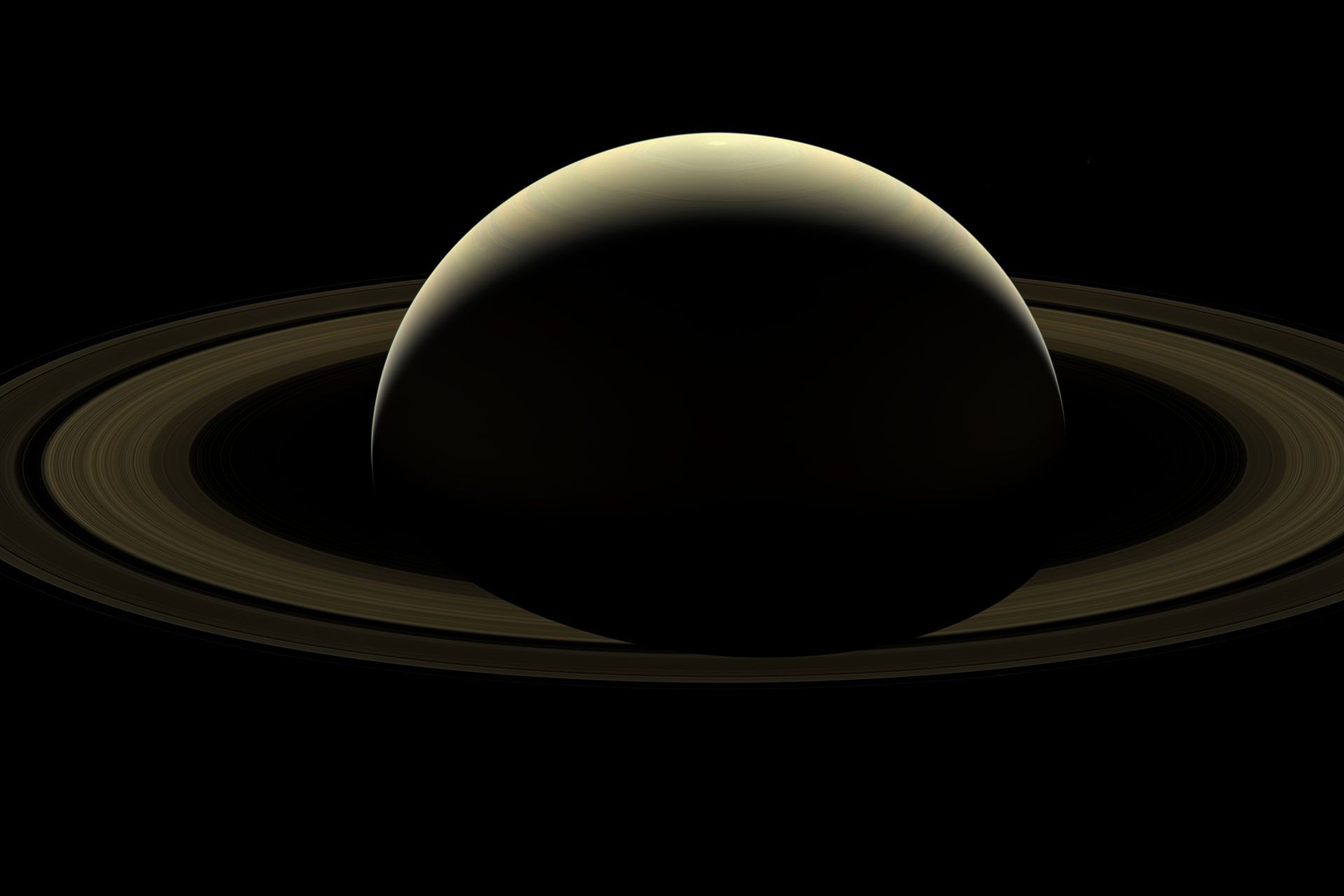
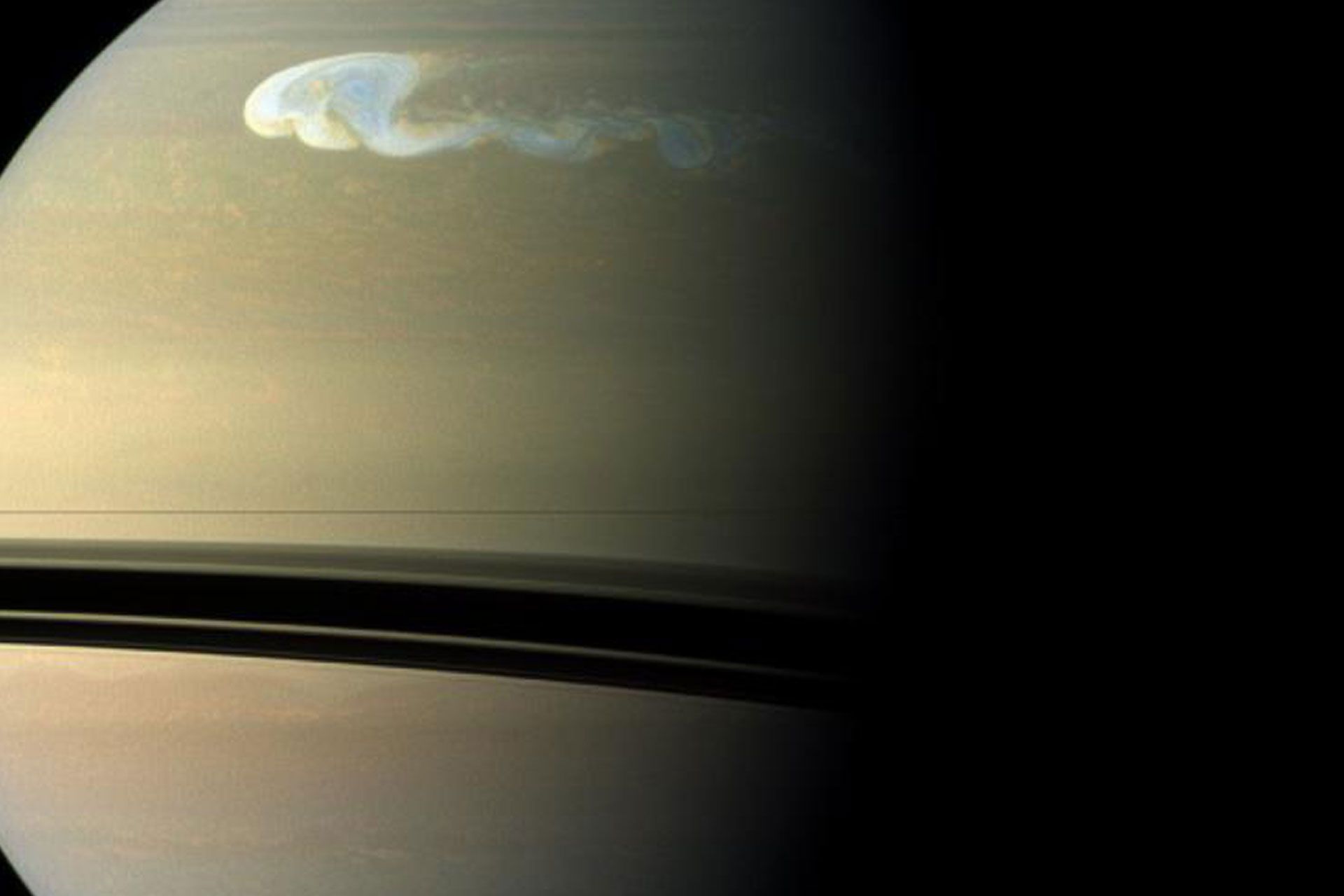

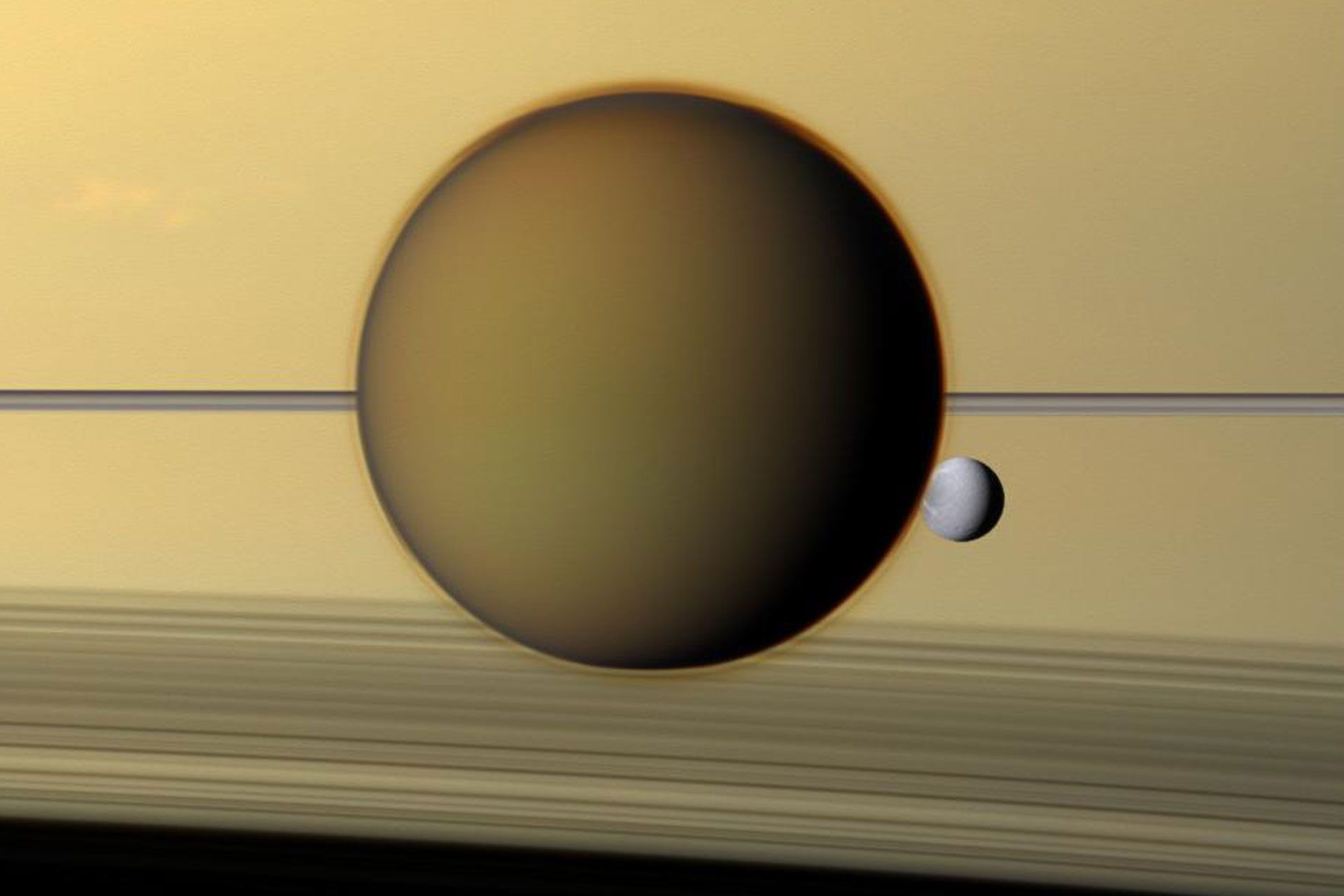
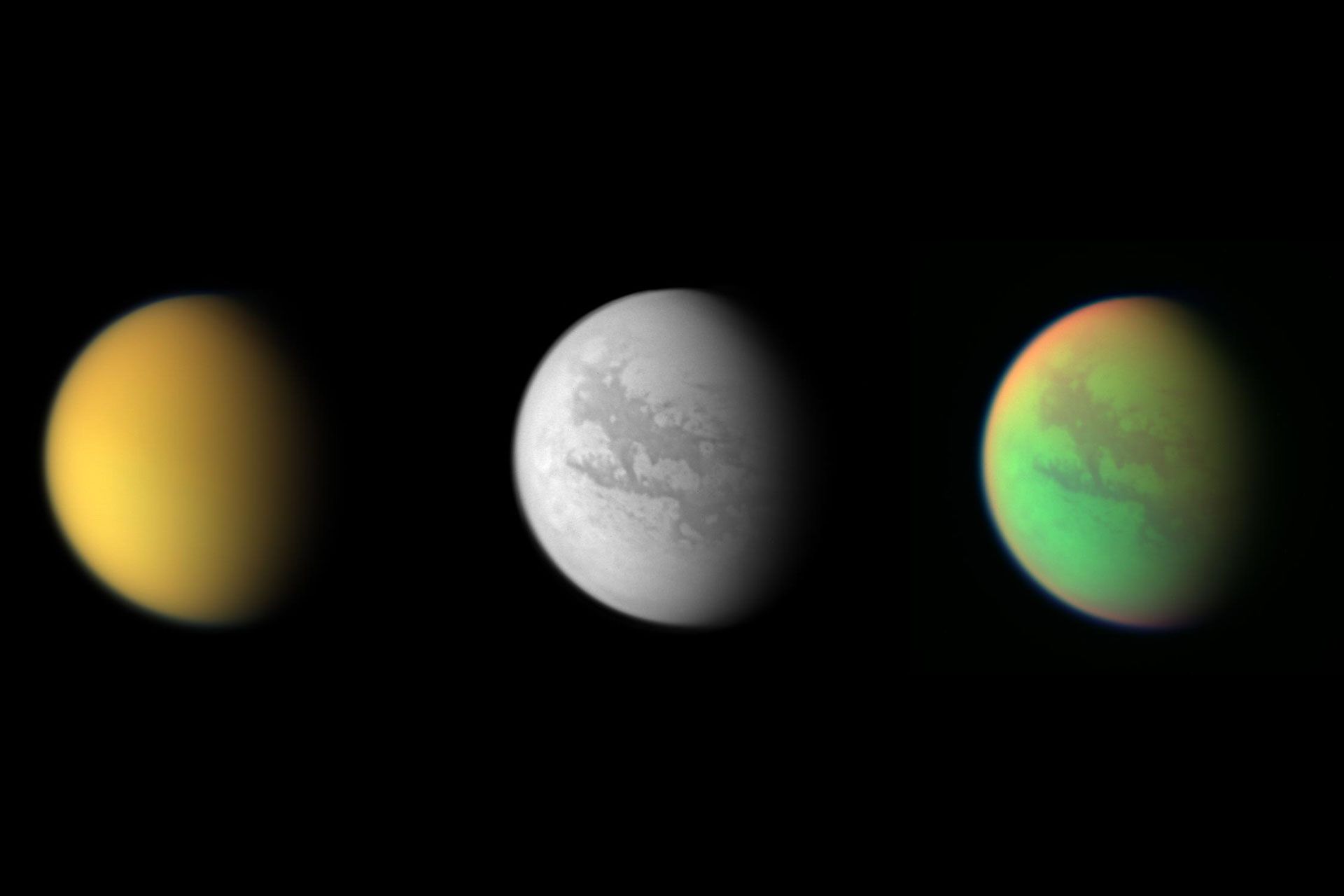
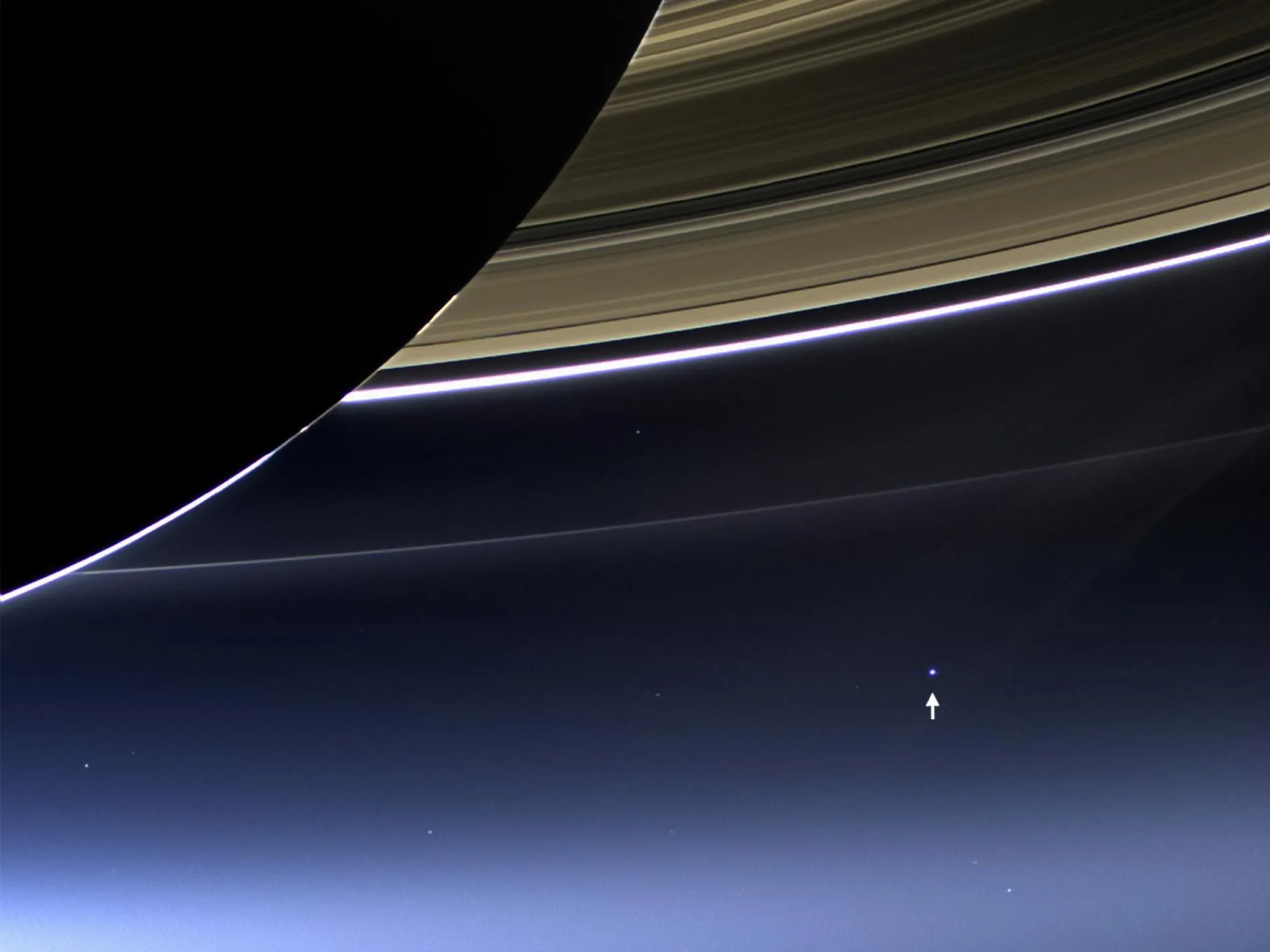
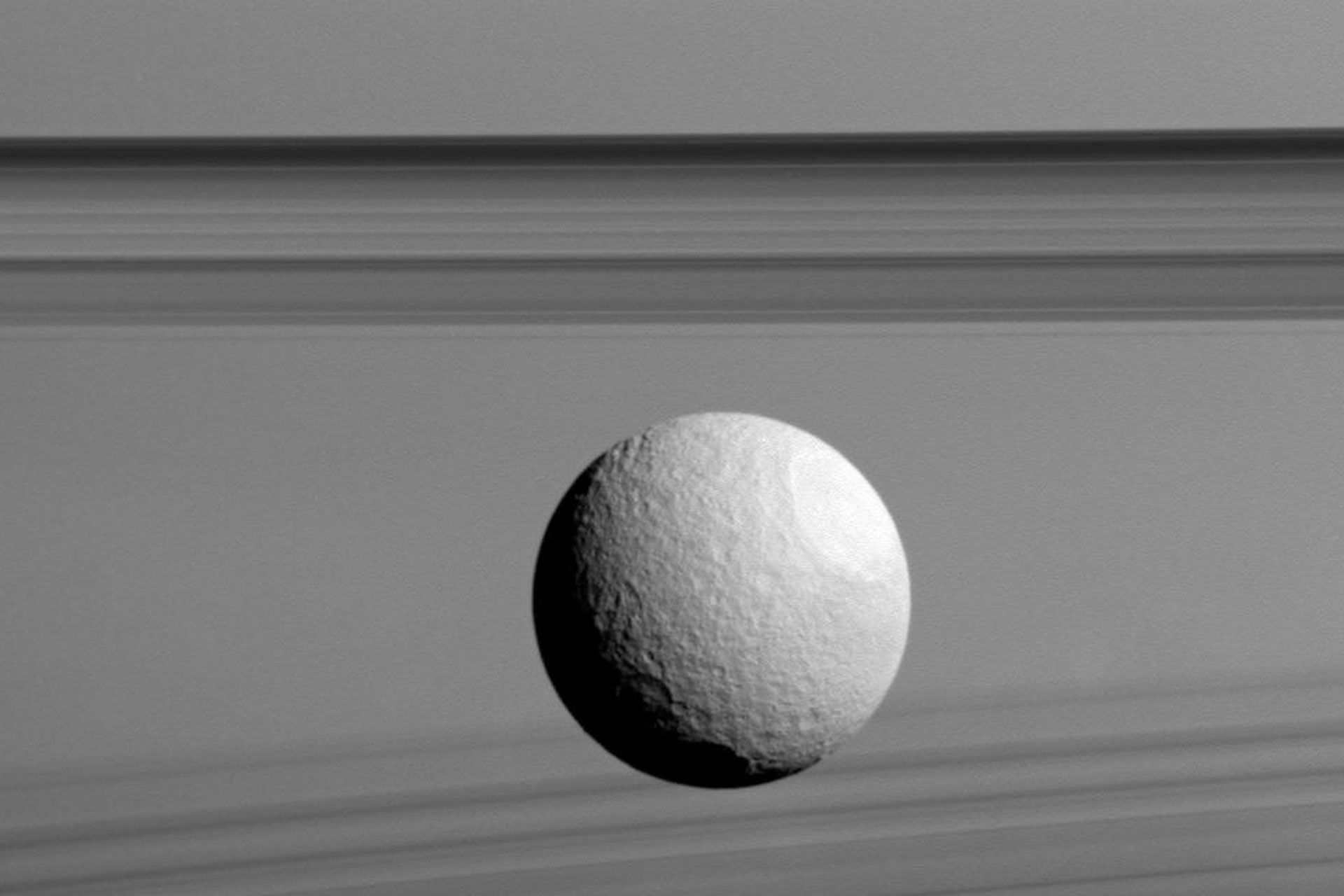

A selection of images captured by the Cassini Huygens spacecraft
Farewell to Cassini
Cassini’s last data was transmitted to Earth on September 15, 2017; Then this probe was destroyed by collision with Saturn’s atmosphere. This was Cassini’s last orbit around Saturn after 13 years of exploration and investigation. According to NASA experts, Cassini disintegrated 45 seconds after its last transmission due to the heat and friction of the fall.
Shortly after Cassini broke up, its mission planner Eric Sturm outlined his plan to report on his and his team’s experiences on the mission. The mission is over, but its scientific results will be published for decades to come because the entire data has not yet been analyzed.
Future missions to Saturn
Among the proposed plans for explorations on the planet Saturn, the robotic probe Dragonfly has reached the approval stage of NASA. The probe is in the form of a drone and will investigate hundreds of locations on Titan, Saturn’s moon. It will also sample and measure the composition of biological materials on the surface of Titan and search for life on this moon. Dragonfly will launch in 2026 and reach Saturn in 2034.


You may like
-

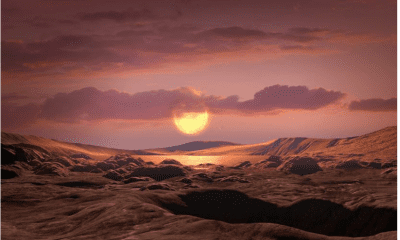


Most alien planets probably do not have day or night
-




The biography of Edwin Hubble
-

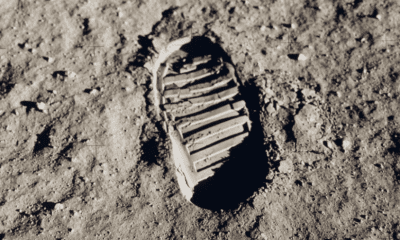


Can telescopes see astronaut footprints on the moon?
-

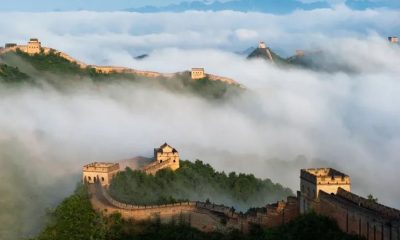


Can you really see the Great Wall of China from space?
-

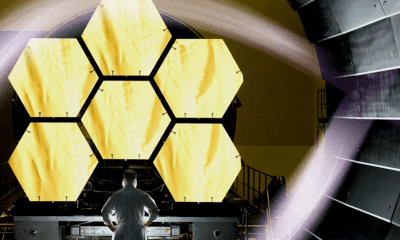


The James Webb Space Telescope; A look at the vastness of the universe
-

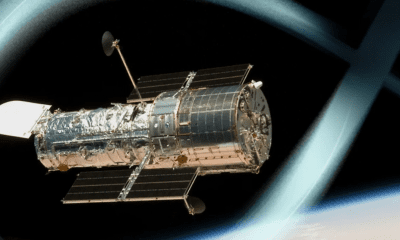


Hubble Space Telescope; A portal to the mysterious depths of the universe
Technology
What is Kali Linux? Everything you need to know about this popular but mysterious distribution
Published
24 hours agoon
15/09/2024

What is Kali Linux? Everything you need to know about this popular but mysterious distribution
In today’s technology era, as devices and tools become more advanced, their negative and destructive side also become more complex, and as a result, interaction with them requires more care. Currently, with the pervasiveness of the Internet the strong dependence of our daily lives on it, and the emergence of artificial intelligence, cyber threats have also increasingly spread, and the news of hacking various platforms is heard from left and right.
Considering the cyberization of part of people’s lives (entertainment, chat, and earning), the importance of strong cyber security measures cannot be ignored. Kali Linux or in English Kali Linux is a powerful and open-source Linux distribution that is specifically used for penetration testing and digital research and is considered one of the most important tools in the field of cyber security.
 Kali Linux 2024.3
Kali Linux 2024.3
Every techie has probably thought of installing Kali Linux, even via a virtual machine, to poke around and entertain their inner little scientist.
When users first encounter Kali tools, they see strange names such as BeFF Bettercap Hashcat Metasploit, or Nmap, which are almost difficult to guess their use from the name. Overall, Kali is a powerful distribution, and working with it requires a deep understanding of its tools.
What is Kali Linux?
Kali Linux, formerly known as BackTrack Linux, is a Debian-based Linux distribution developed by Offsec. This Linux distribution hosts hundreds of different tools used for penetration testing, reverse engineering, and vulnerability detection of networks and websites.

Due to the fact that Kali is developed based on Debian, it has high stability and security, and its Debian base allows it to benefit from vast software repositories and a similar package management system. In addition, if you are in the category of users who are already familiar with Debian Linux distributions such as Ubuntu, navigating Kali will not be difficult for you; But for users of other operating systems to enter the world of Linux, learning Kali takes more time.
Another important goal of Kali developers is to give the user unlimited freedom to have an open-source and ever-evolving platform and not just be limited to the tools available on the platform. Thus, even the most detailed parts of the software on Kali are open to optimization by the user.
Who uses Kali?
If you are imagining a sequence of Mr. You’re Robot, which depicts a hall full of professional hackers, and the hackers are sitting behind their systems in hoodies, you’re completely wrong. The use of Kali Linux does not require special clothing and there are professional and skilled experts who appear in their company and workplace every day and are responsible for simulating attacks on the network and discovering and fixing its vulnerabilities.
Other people for whom the use of Kali Linux is useful are instructors who plan to train the next generation of white hat hackers and ethical hackers, and Kali Linux is considered the best toolbox for training.
Key features of Kali Linux
Kali Linux has a variety of tools in various categories, including intelligence gathering tools, vulnerability analysis tools, wireless attacks, password mining, and social engineering tools. Do not forget that one of the main foundations of hacking and penetration is social engineering.
 Kali Linux tools menu
Kali Linux tools menu
In Kali Linux, you can use Nmap to scan a network and identify its open ports, Metasploit tool is also provided to exploit a vulnerability, and Wireshark should be used to go deep into the traffic of a network.
Tools like Wifite and Airgeddon are also pre-installed on the Kali platform to check the security of your Wi-Fi network. In fact, Wifite automates the process of cracking WiFi passwords, while Airgeddon provides a convenient environment for assessing wireless network security.
Regardless of the tools and programs that are available by default on the platform immediately after installation, users can install other programs they need by connecting to the Internet by learning how to install the program on Linux.
 Metasploit tool on Kali Linux
Metasploit tool on Kali Linux
The Kali developers have paid attention to every detail and even included a custom kernel kernel for packet injection, which plays a key role when working with Wi-Fi. In addition, all packages are signed with GNU Privacy Guard to assure the user about the security of the platform.
Features of Kali based on the introduction on the official website:
- It is free and will always be free.
- Git is open source.
- It conforms to the Filesystem Hierarchy Standard.
- It is compatible with a wide range of devices.
- It is developed in a safe environment.
- Supports multiple languages; Of course, the platform tools are in English.
- Compatible with ARMEL and ARMHF.
Why is Kali Linux not suitable for everyone?
Kali tools are very powerful and require the same amount of knowledge and experience to use them properly. For example, a normal user might want to scan his home Wi-Fi network and find possible vulnerabilities by installing Kali. But in this process, with Kali’s tools, he creates a problem that has serious consequences for him.
 Installing the program in Kali Linux through the terminal
Installing the program in Kali Linux through the terminal
Suppose you try to execute a script without sufficient knowledge and because Kali is connected to the Internet, this script affects the computer of a certain person or organization. Do not forget that Kali is not designed and optimized for the everyday use of ordinary people and common tasks such as web browsing, editing documents and watching movies.
Go to Ubuntu to satisfy your curiosity and experience the Linux environment
If you are just curious about working with Linux and getting to know the environment of Linux distributions, better options can be found compared to Kali. Usually, the most recommended migration from other platforms to Linux ends up with the Ubuntu distribution, which has a user-friendly interface and a huge support community and runs everyday processes like any other operating system.
Linux Mint is another option recommended for beginners, especially for users who are used to traditional desktops. On the other hand, Windows users usually associate more with Zorin OS. These distributions are all developed for everyday use and perform tasks such as web browsing, editing documents and even running games very well.
Getting started with Kali
Finally, if you decide to install Kali Linux, you should download it from the official Kali website. On the Kali website, you can see different versions of Kali for installation in different ways, and according to your conditions and desired installation method, you can download the desired version.
To install Linux distributions, it should be noted that it is possible to install Linux on Flash or that the user can install the desired distribution on the virtual machine. Installing Kali on a virtual machine has the advantage that all events are kept in isolation and no damage is done to the user’s main operating system.
The Kali Linux distribution is considered the most popular platform for hackers and is designed for specific purposes where everyday use is not among its goals; Therefore, it is not necessary to install it for specialized work and of course to meet the needs of curiosity, but for normal use it is recommended to go for other distributions of Linux.
Dear Zomit users, what is your opinion about the user experience with Kali Linux? Do you recommend installing it?
fashion
Sony Brand Story; From the production of rice cookers to becoming one of the most famous companies in the world
Published
1 day agoon
15/09/2024

Noun: Someone who assists () a goal.
Sony brand story; From the production of rice cookers to becoming one of the most famous companies in the world
Sony is a Japanese multinational company headquartered in Minato, Tokyo. This company provides electrical services, gaming, entertainment, and financial services.
Sony is known as one of the pioneers in the production of electrical products and in recent years it has improved its position among the top companies in the world. Sony consists of many subsidiaries, the most famous of which are Sony Pictures, Sony Music, Sony Mobile, Sony Entertainment, and Financial Holding.
The story of the formation of the Sony brand
Masaru Ibuka returned to Tokyo from World War II in September 1945 to start a new job in the Japanese capital. He set up his workshop in an old, war-torn building with only eight employees. Their initial office walls were full of cracks and had no windows, but over time as their business progressed, the office building also improved.
In October of that year, Ibuka and his group launched a new company called Tokyo Tsushin Kogi, or Tokyo Institute of Communications Research. At that time, everyone was eager to work in the new company and wanted to use their engineering knowledge to rebuild Japan. However, no one knew where to start. Most of the employees were paid from Ibuka’s small savings and they had to work hard to survive.
The story of the formation of Sony goes back to 1945; When Masaru Ibuka returned from World War II
At that time and during the Second World War, people were thirsty to hear the news of the day. As a result, they came up with an interesting idea that changed the fate of the company forever. Most of the radios at that time were either destroyed by the war or could not receive radio waves due to police interference.
The Ibuka company repaired broken radios and also made it possible to receive waves using a series of converters. It didn’t take long for this model of radio to gain many fans among people.
Their business was in the center of attention and for this reason one of the Japanese newspapers published an article about them. This article not only got them more customers but also brought Ibuka’s old friend, Akio Morita, closer to him.
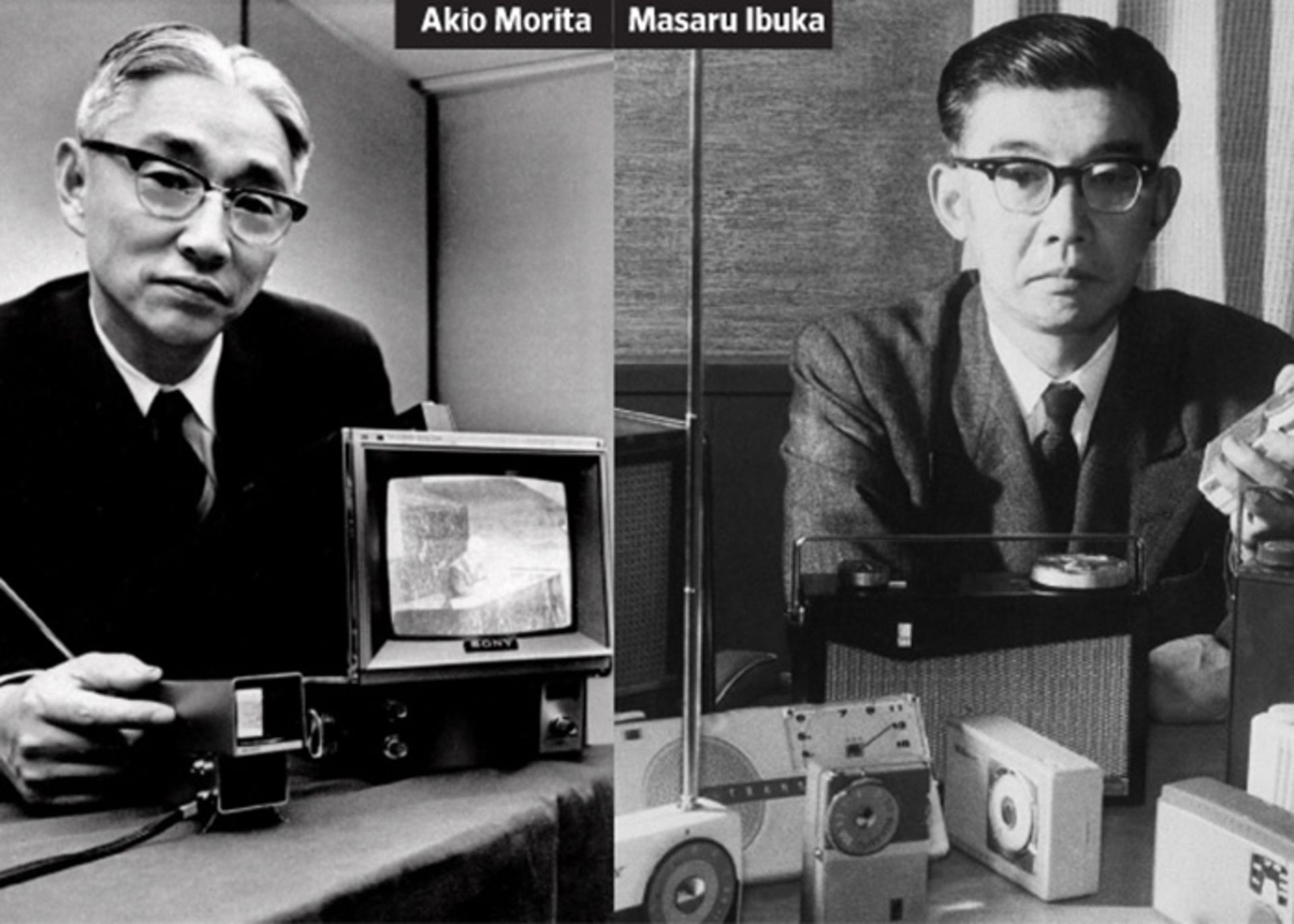
Ibuka and Morita, the founders of Sony Corporation, first met on a research committee studying new types of war weapons.
After some time passed, despite the big age difference, a deep friendship between Ibuka and Morita was formed. After the end of the war, Morita returned to his hometown and the communication between them was cut off. Until one day he read his friend’s name in a newspaper article and called Ibuka. Ibuka also asked him to get to Tokyo as soon as possible to start working with him again.
Sony’s brand name was originally supposed to be TTK or Totsuko
They were looking for a new name to advertise their company globally. Their intention was to choose the abbreviation of the company’s name, TTK, for advertising, but this name was already used. The word Totsuko was also another suggested name. But during his trip to America, Morita realized that it is difficult for Americans to pronounce this name.
They finally chose the name Sony from the combination of 2 words Sonus meaning sound and Sonny meaning young boy. Their purpose in choosing this name was to pronounce it in the same way in all languages of the world.
The company’s first product was a rice cooker, which, contrary to expectations, failed to meet expectations and failed. They did not get discouraged after their first failure and devoted more money to research. They focused on developing products that would benefit the Japanese people.
Sony; The first brand
During 77 years of operation, Sony has been able to launch the first product in many markets of the world. From Japan’s first tape recorder to Japan’s first transistor radio and other products.
Tape recorder

In 1950, the first Japanese tape recorder was made from its American model. This device was also not well received until Sony released a translated version of 999 Ways to Use the tape recorder.
After people became familiar with the product’s uses, the purchase request increased and the Sony tape recorder sold well. The demand for this product increased so much that the company had to expand its facilities to produce orders.
Transistor radio
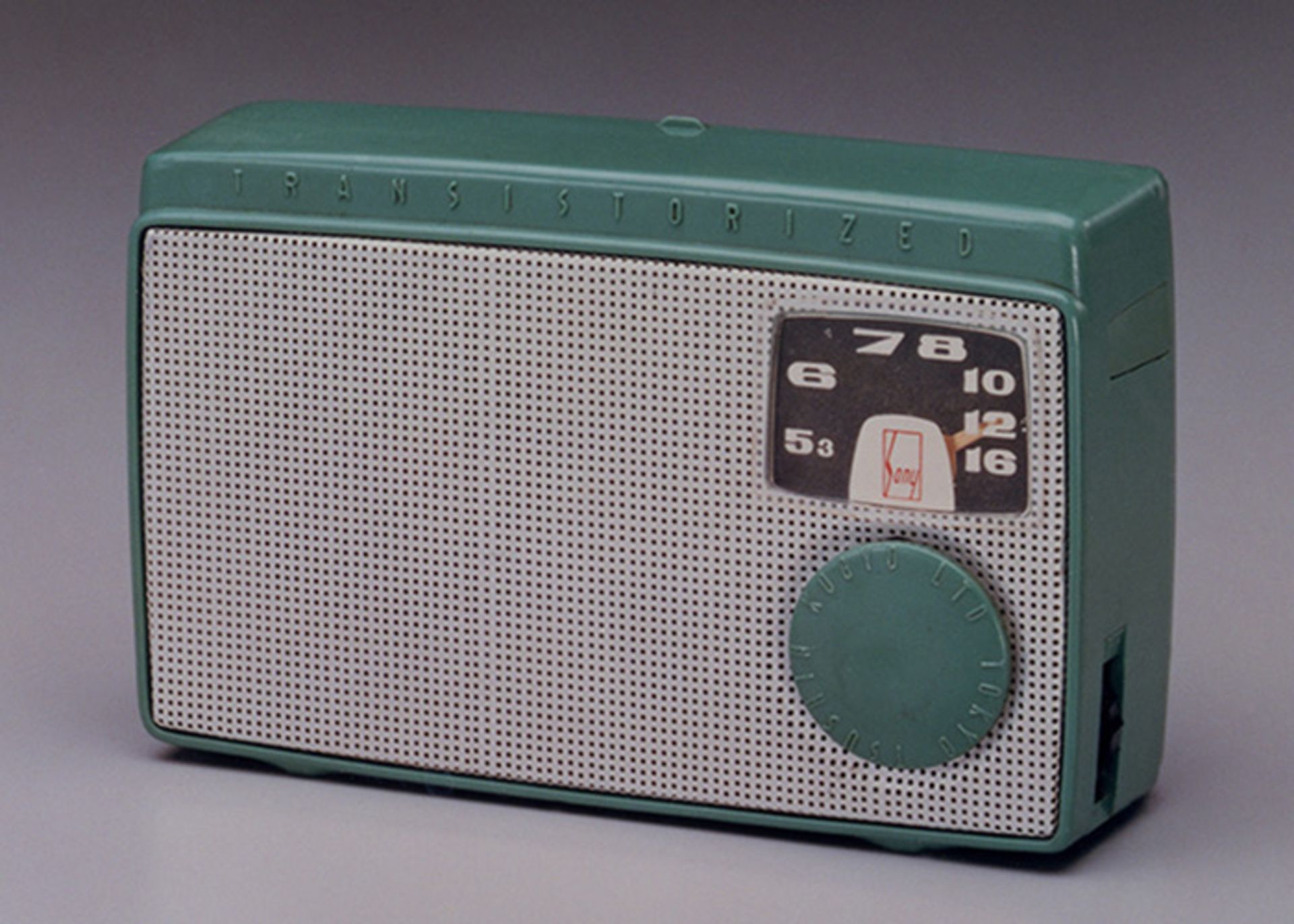
Japan’s first transistor radio was introduced in 1955 by Sony.
Portable TV
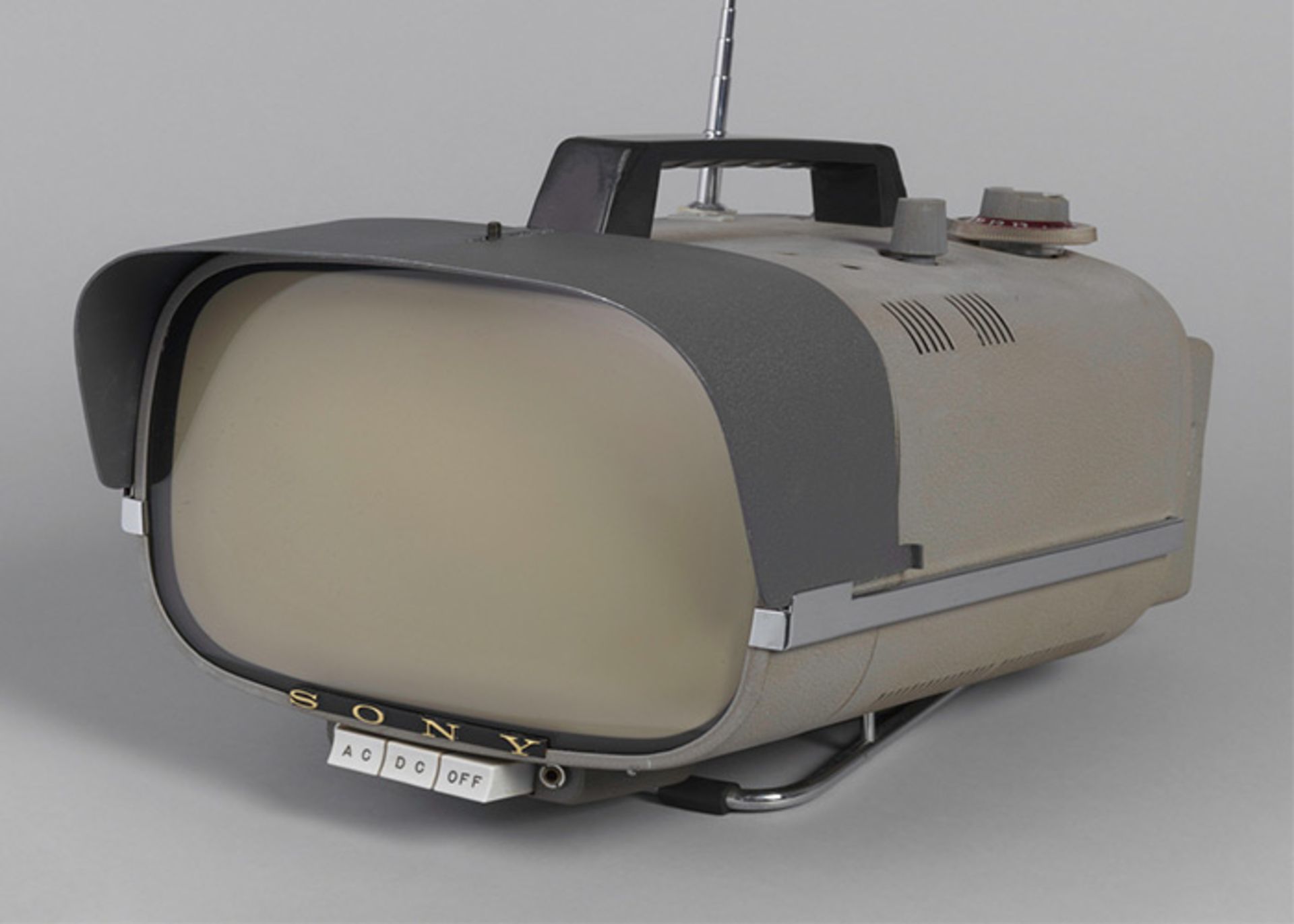
In 1960, Sony released the world’s first portable transistor TV. Sony used radio technology to produce this device.
The televisions of that time were big and in every house, a specific room was reserved for them. But these products brought a new definition of personal televisions to the market.
Video tape player
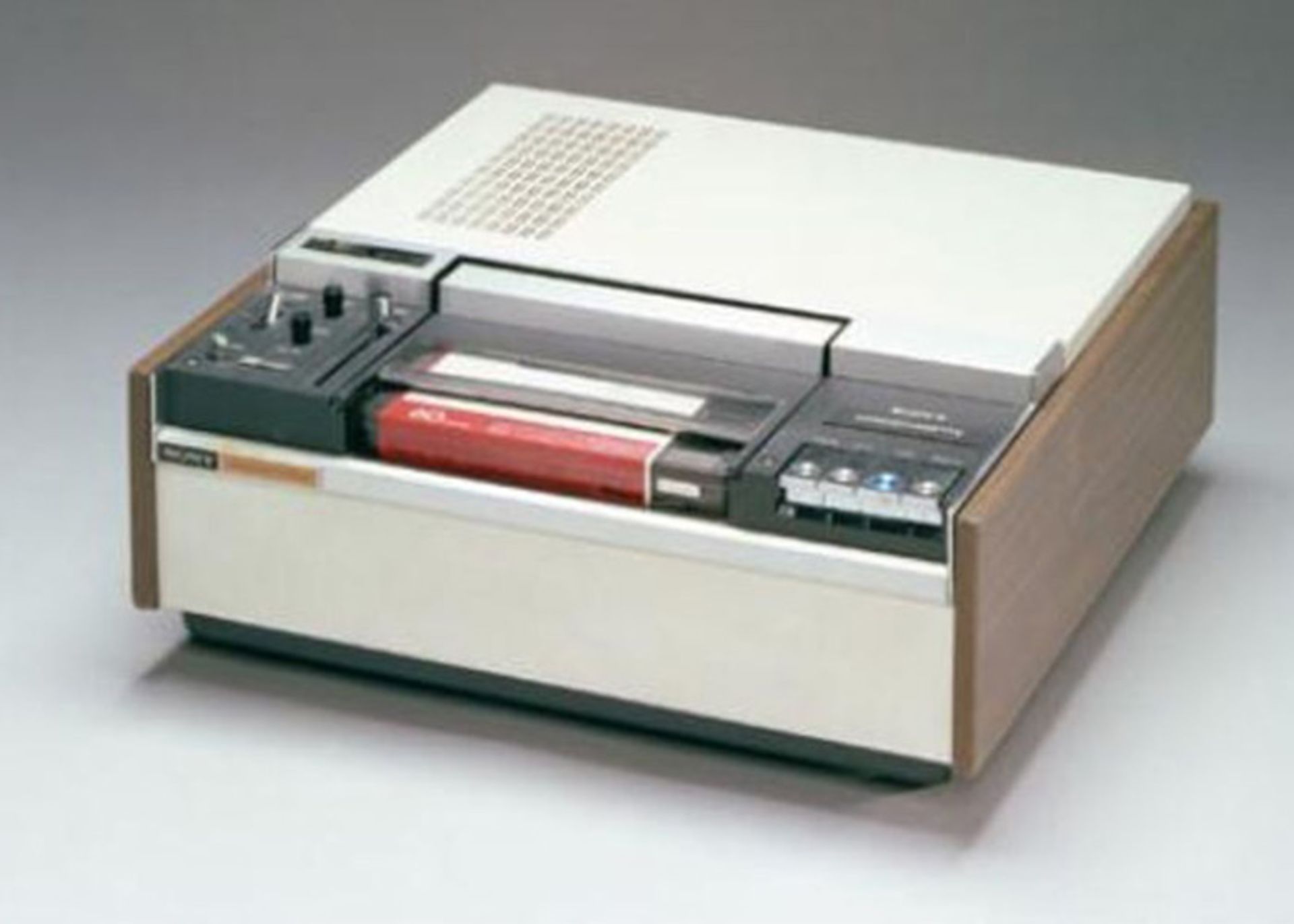
In 1971, Sony unveiled another product. This player was able to show videotapes in color inside the TV.
Masaru Ibuka retired in 1976 and was succeeded by Akio Morita as CEO.
The first generation Walkman

In 1979, Sony launched the first generation of Walkmans. These devices were portable and customers could listen to their favorite cassettes anywhere.
Many employees of the company believed that this device could not become popular among people without the ability to record sound. But contrary to their belief, this device introduced a new and successful lifestyle among people and achieved remarkable success.
The first CD player
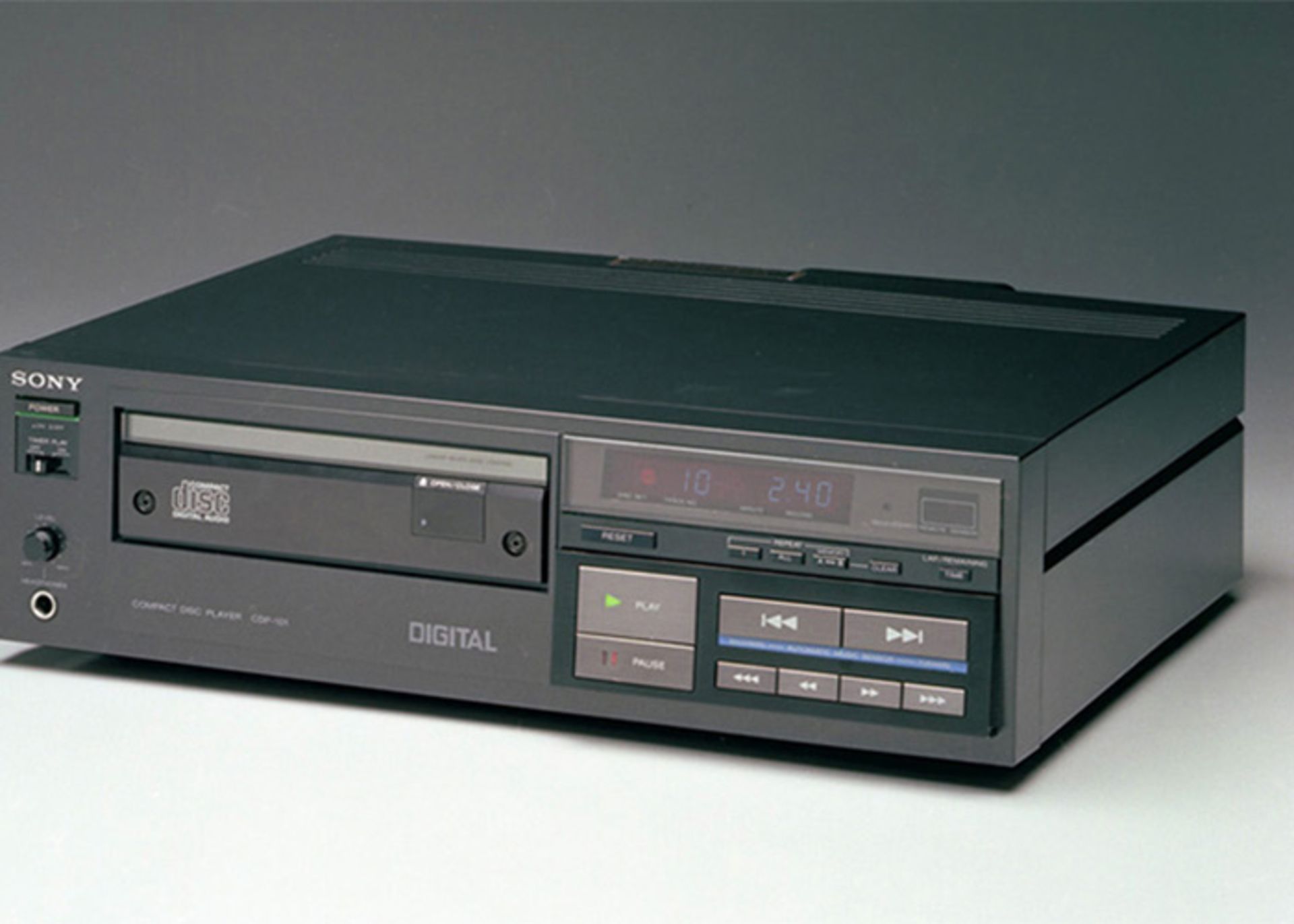
The world’s first CD player was launched in 1982 by Sony.
One of Sony’s senior managers, Norio Oga, was elected as the company’s CEO in 1989. Sony bought Columbia Pictures in the same year. This action was considered the biggest purchase of a Japanese company at that time.
PlayStation
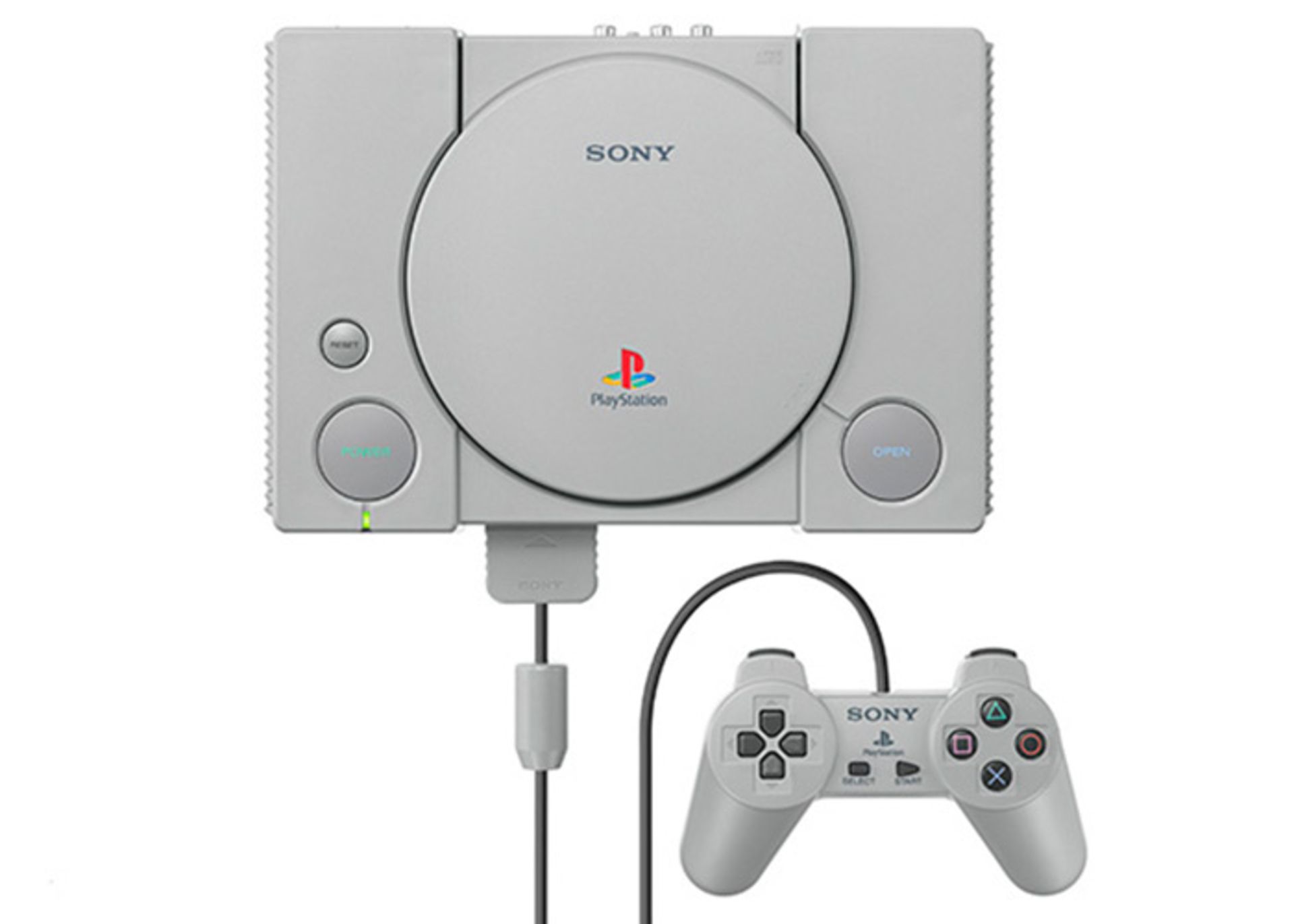
PlayStation is another important product of Sony. This product was sold in the Japanese market in 1994 and entered America and Europe in 1995.
PlayStation became so popular among people that its sales reached 10 million units by the end of 1996, and in 1998, about 50 million of this console had been sold. The production of new models of this product continues and today PlayStation 5 is considered the newest Sony console.
Digital camera
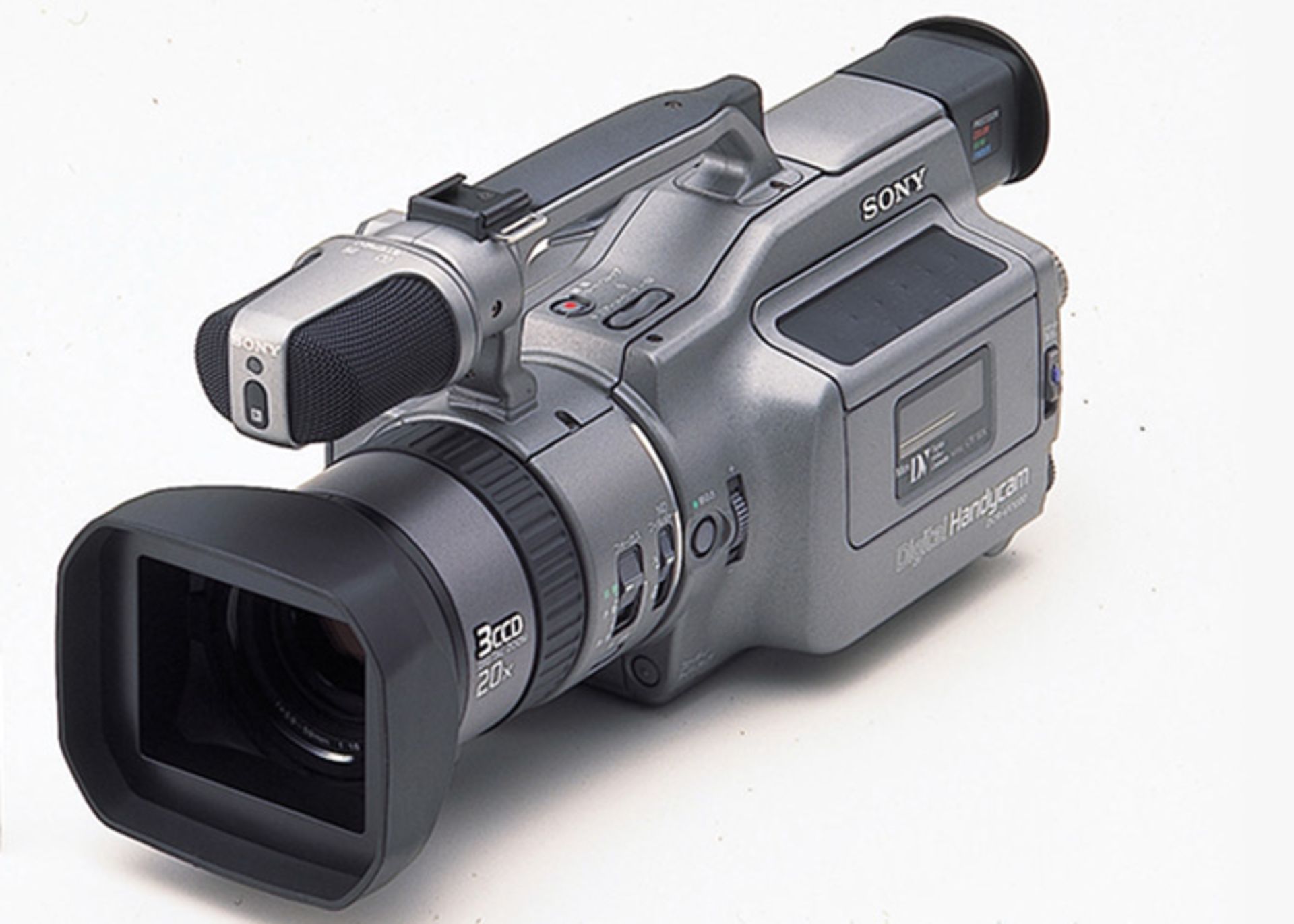
The first digital camera was launched by Sony in 1995. This device was very well built and recorded high-quality videos.
Sony Mobile

Sony Mobile Company started working in 2001 in cooperation with Ericsson. The company’s products were first marketed under the name of Sony Ericsson until Sony bought Ericsson’s shares in 2012. Since then, the phones of this company have entered the market under the name of Sony.
In 2012, Sony was able to win the title of the fourth mobile phone manufacturer. Xperia series mobile phones are the current flagships of this company. The Xperia brand doesn’t sell much at the moment, but Sony continues to produce products.
Vaio laptop

The first generation of Vaio laptops was launched in 1997. These laptops had a slim body and introduced a new concept of personal computers to the world.
Personal life of Masaru Ibuka

Masaru Ibuka was born on April 11, 1908 in Nikko, Japan. He graduated from the university in 1933 and worked in a film production company. Ibuka joined the Navy during World War II and was a member of the investigative committee; But after some time in 1945, he left the war to start his own radio repair workshop in Tokyo.
At that time, people followed the news of the world through the radio. As a result, starting a radio-related business was a good idea for a company. Ibuka and Akio founded Sony in 1946. Ibuka used transistors to make his company’s products. Therefore, Sony was introduced to the world as one of the first companies to use this technology for non-combat purposes.
Ibuka was a member of the Navy during World War II
In 1976, Ibuka was awarded an honorary doctorate from the University of Tokyo. He received two other honorary doctorate degrees in 1979 and 1994 from Tokyo and American universities.
Ibuka published a book titled “Kindergarten is Too Late” in 1971. In this book, he claimed that the most important time for human learning is from birth to three years old. As a result, he has suggested ways to teach skills to children at this time.
Ibuka was the leader of Sony until 1976 and then he retired; But even after that, he had a close relationship with company managers and guided them. He died in 1997 at the age of 89 due to heart failure.
Personal life of Akio Morita
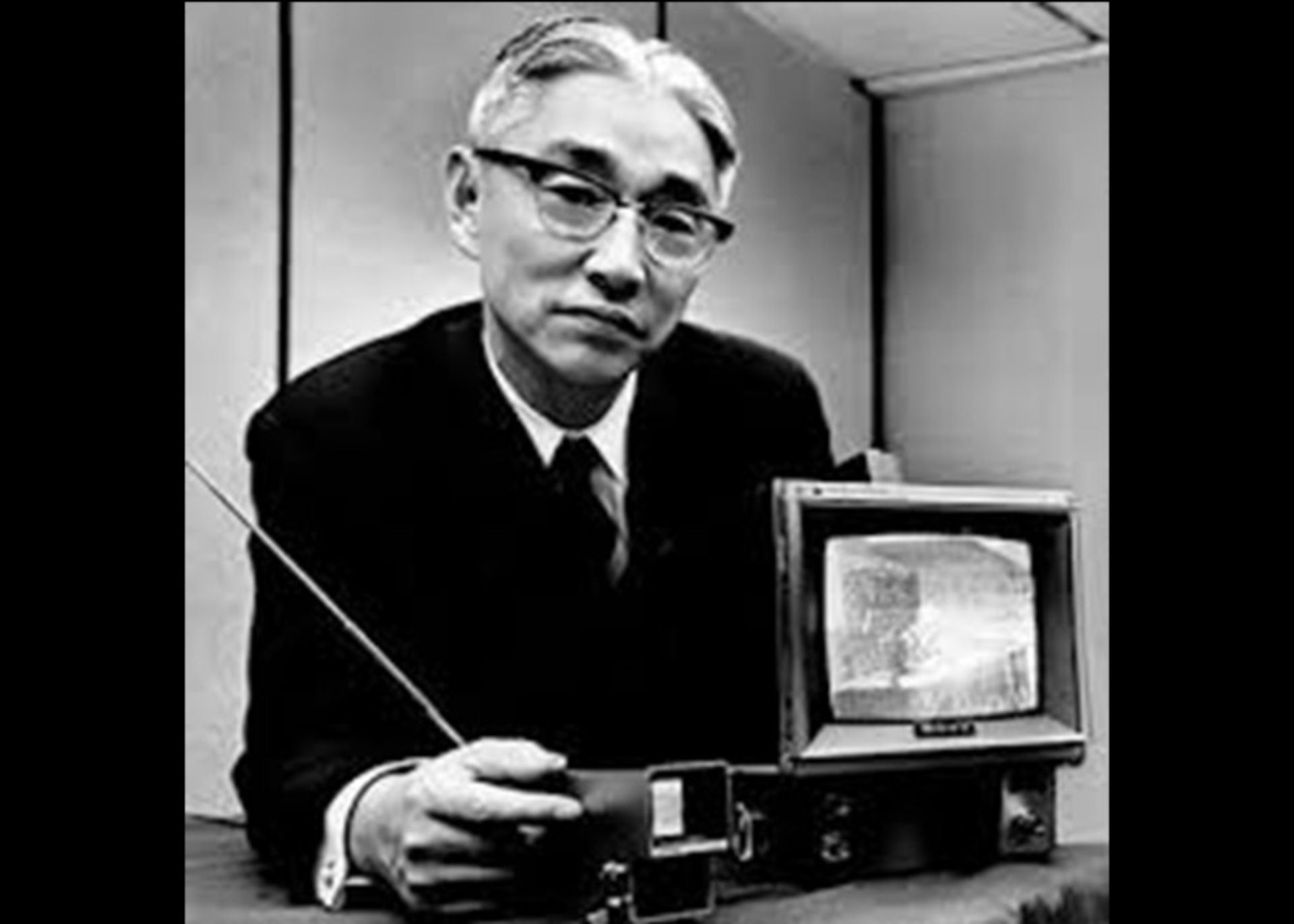
Akio Morita was born on January 26, 1921 in Japan. He was the eldest of his four siblings. As a result, his father trained him to manage the family business.
Akio was very interested in mathematics and physics and graduated from university with a degree in physics. During World War II, he became a member of the Japanese Army’s Research Committee, and while serving, met his future business partner, Masaru Ibuka.
Morita was a huge fan of all Sony products and worked hard to promote them. For example, the size of their first production radios was slightly larger than the standard shirt pocket size. Because they wanted to market their products as pocket radios, Morita made shirts for their employees with larger pockets to show customers that these radios were pocket radios.
Sony established its first branch in America in 1960. Sony was the first Japanese company to enter the US stock market. In 1994, Morita suffered a stroke while playing tennis and resigned from the chairmanship of Sony. He finally died of pneumonia in 1999 at the age of 78.
Sony failures
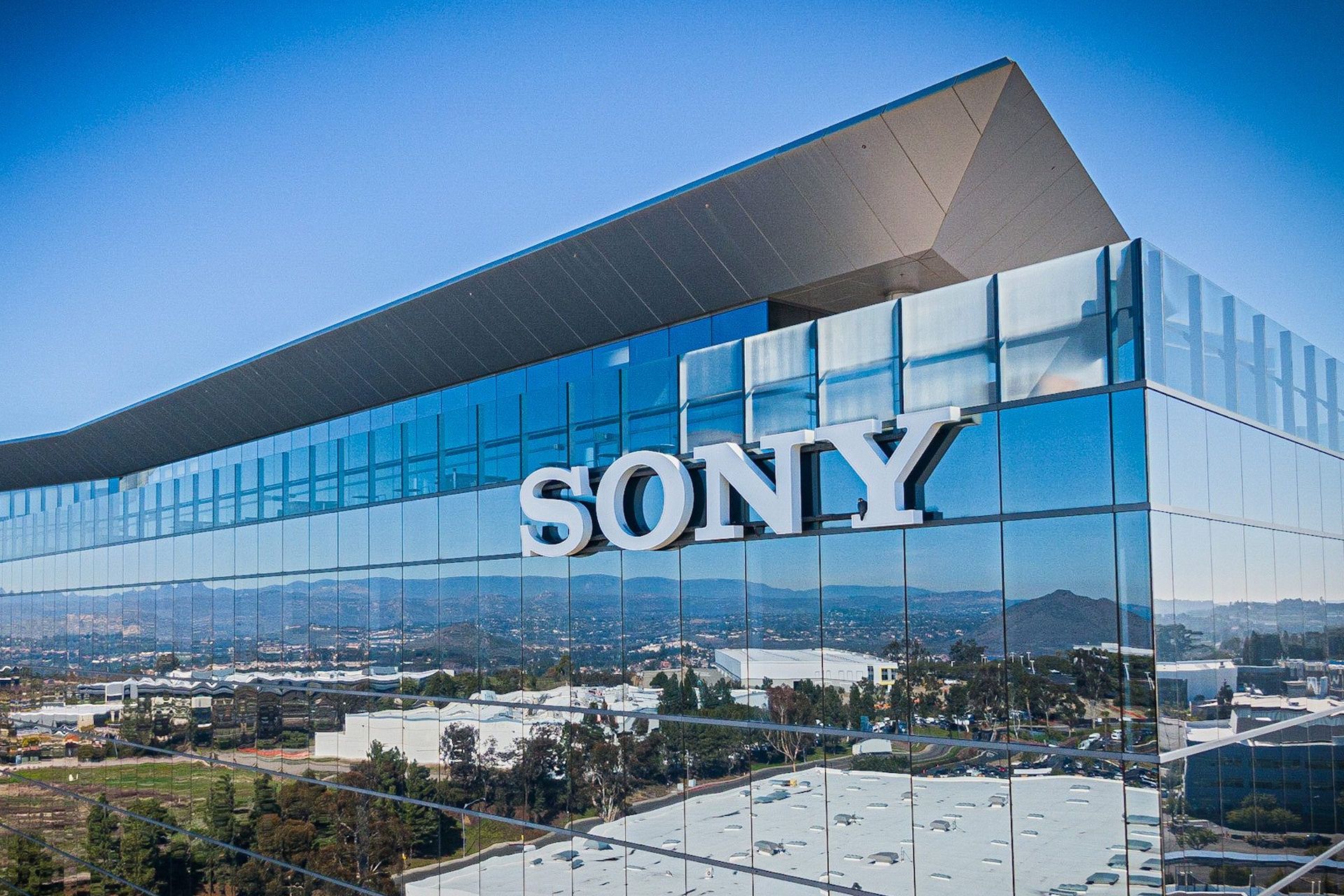
Since its establishment in 1964, Sony has produced successful and innovative products. Many of these products were entering the market for the first time, and as a result, they introduced a new concept of technology to the world; But no success story is without failures.
Sony Aibo

Sony robots were launched in 1999. These robots were in the form of cute dogs and had the power to learn. These robots could show emotions such as happiness, sadness, anger, surprise, fear and disinterest.
Sony robots were sold at a price of $2,500 and were very popular among their owners. But its high price prevented it from increasing its popularity and eventually, Sony stopped production.
Vaio music device
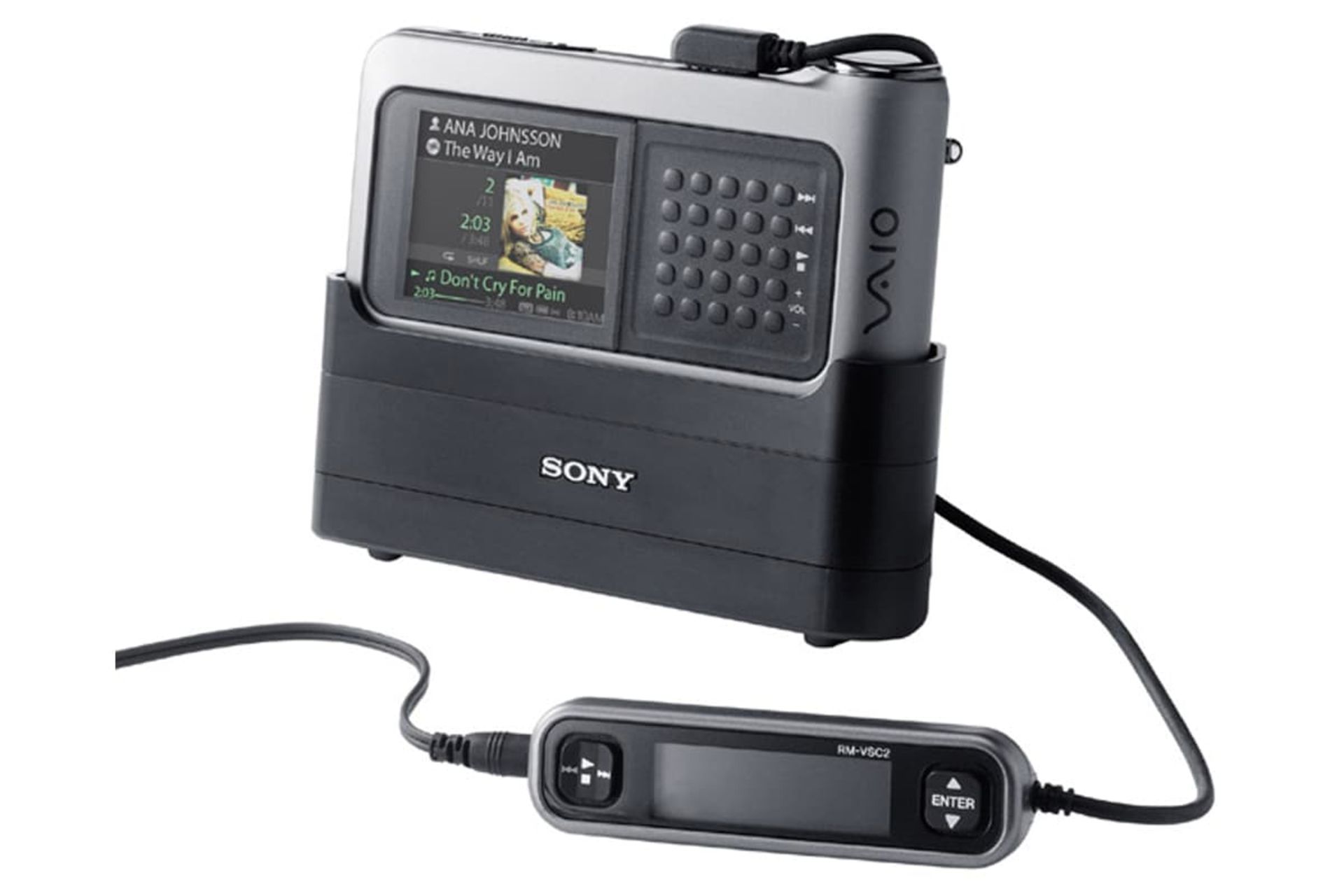
In 1979, Sony introduced a new concept of portability to the market by presenting its Walkman. The company had been Apple’s fierce competitor in digital music for two years, but its first product did not perform well.
The biggest mistake of the company was the dependence of files on the ATRACT format. Files with this format could only be used in Sony minidiscs. The ability to share files was the first word in digital music in 2000, and all files were released in MP3 format. As a result, this issue became a big challenge for Sony.
Sony e-Villa
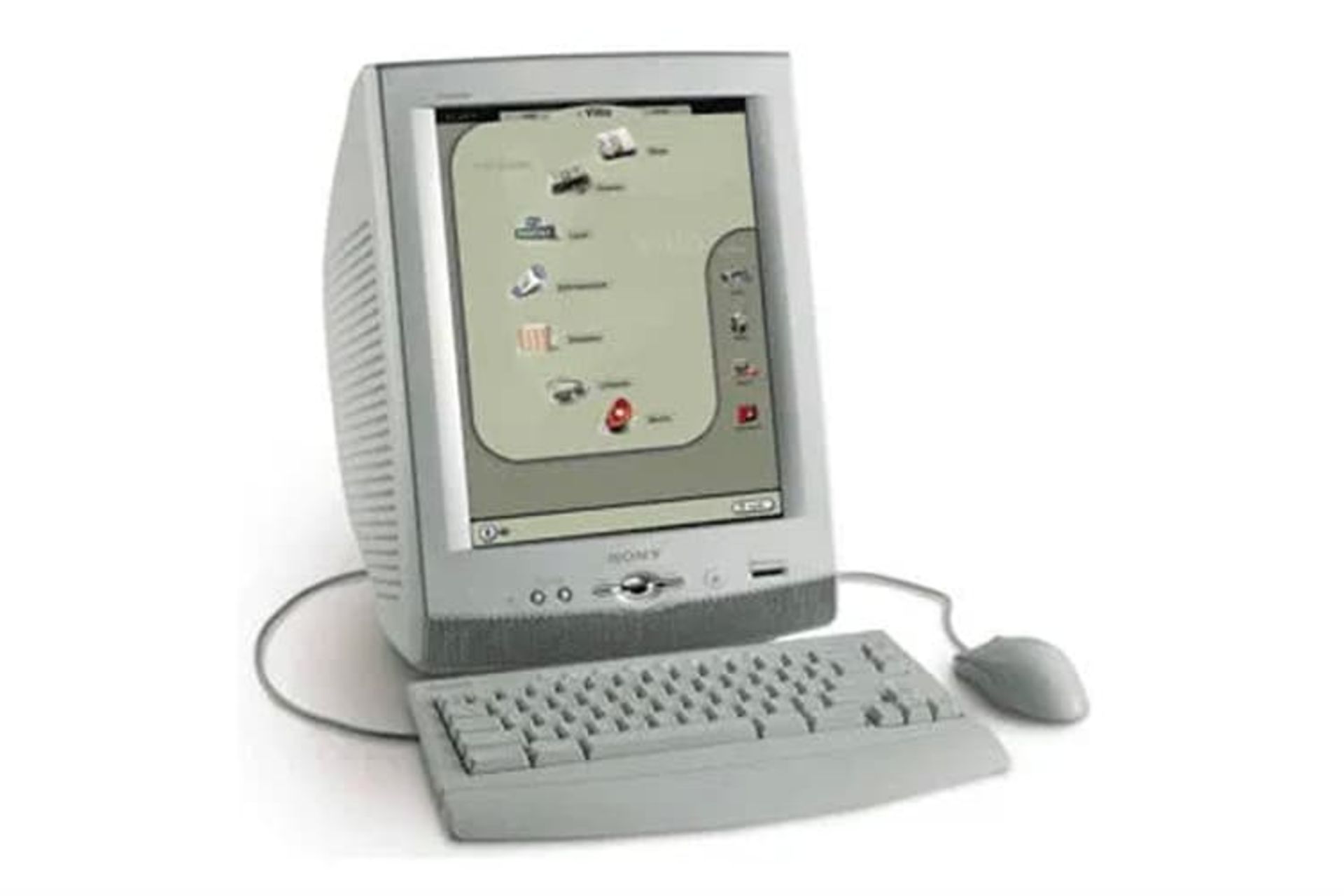
In 2001, many companies were offering Internet home appliances, including dedicated terminals for accessing the Internet and web browsers. Sony e-Villa was also a product that was launched with the same purpose.
The e-villa had a 15-inch monitor and a 56 kbps dial-up modem. e-Villa was designed to have access to email services and websites. At that time, there was a lot of competition between these devices and people preferred to use devices with Windows XP. As a result, Sony stopped the production of these products after three months.
Sony Airboard
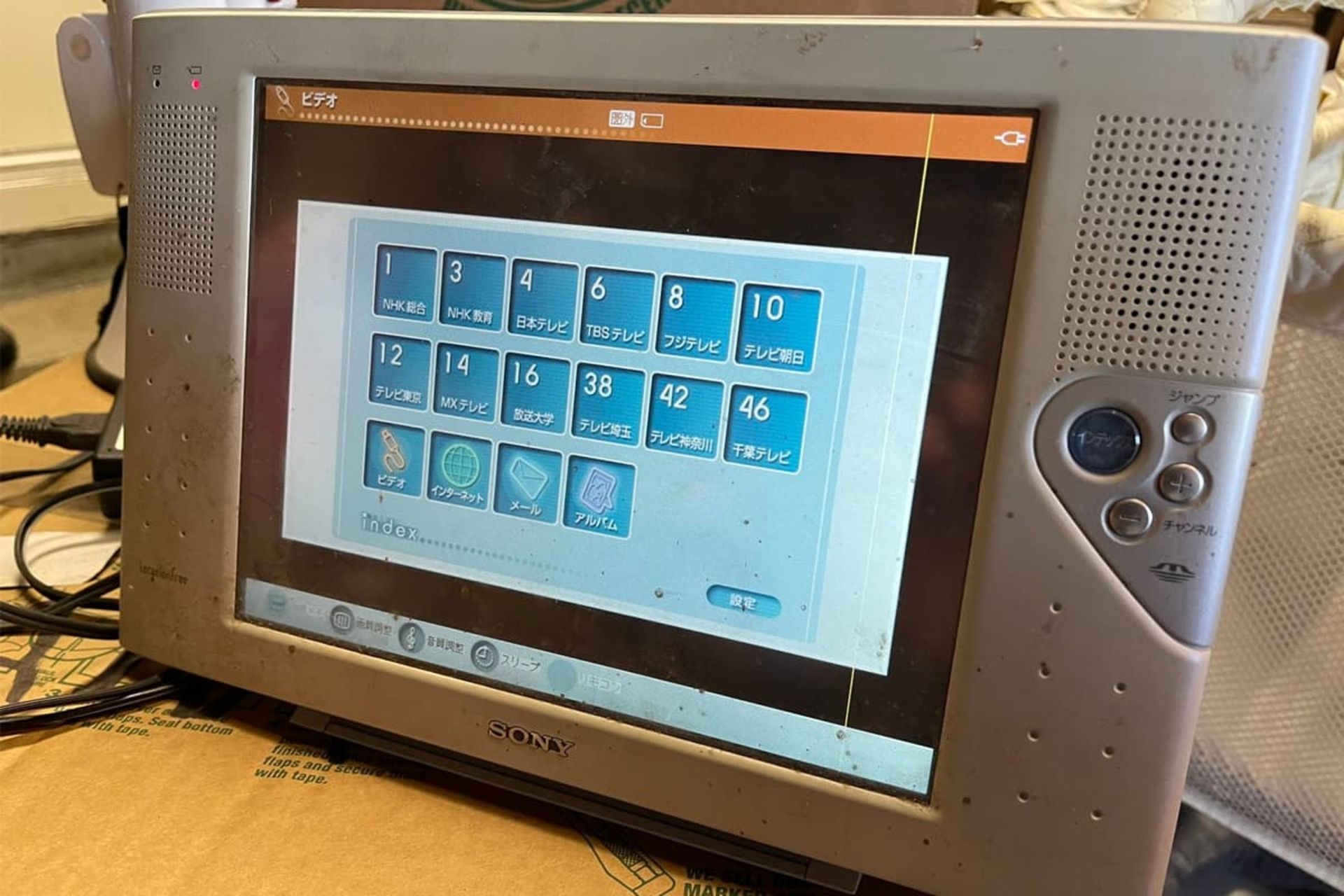
10 years before people became interested in watching videos on tablets, Sony launched a device called Airboard. The tablets of this family were 10 inches and had the possibility to connect to Wi-Fi and broadcast TV channels.
Using the picture-in-picture feature, users could search the Internet and watch TV. This device never caught on because people thought it was just a portable and expensive TV. Therefore, its production was stopped before entering the American market.
Sony PSX
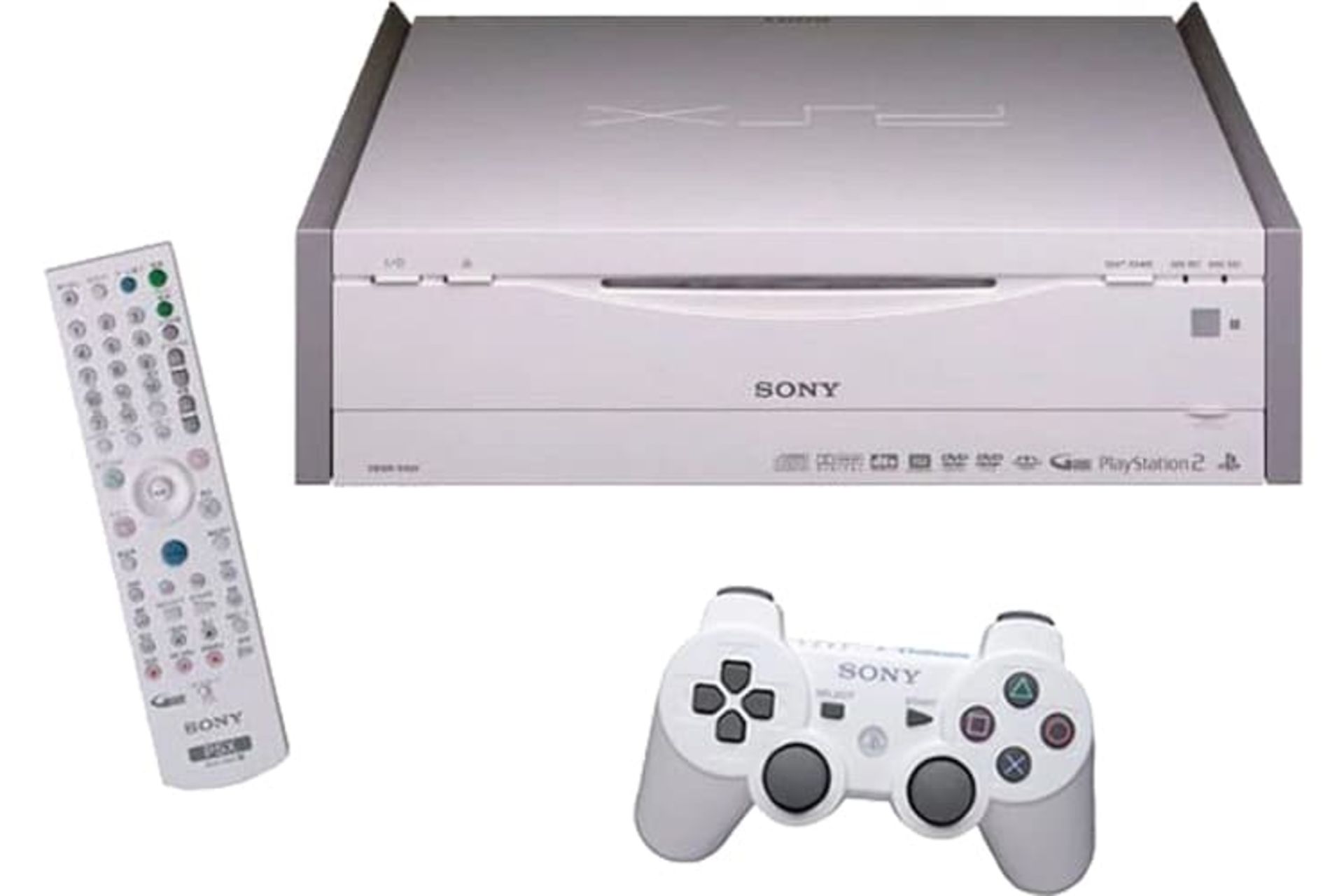
In 2003, Sony combined its two products, the PlayStation 2 and the video recorder, and marketed it as a single product. Using this product, customers could record the TV show on the storage memory or DVD at the same time as the game experience.
But the PSX, which was released only in Japan, was much larger and heavier than the PlayStation. Although this product did not have a high price, it could never attract many customers.
The current state of the Sony brand

Sony is one of the largest Japanese companies by revenue. The company reached the peak of profitability in the 1990s and 2000s due to the launch of its PlayStations, but faced financial problems in the late 2000s.
Read more: Samsung brand story; Full-view mirror of Korea’s commercial history
The global financial crisis, increased competition with PlayStation, and the earthquake in Japan in 2011 went hand in hand with Sony experiencing major failures for three years.
Due to the negative effects caused by natural disasters and exchange rates, the Times magazine called Sony a lack of flexibility and inability to measure the economy, but Sony was able to overcome all the crises in all these years by using innovation and became one of the top companies in the world. become in the television industry.
Sony’s current slogan is Be Moved, and the company aims to emotionally excite its customers with every product it offers.
Sony was able to pocket an operating profit of 1.21 trillion yen (about 8.9 billion dollars) in fiscal year 2022, which is a new record. Sony’s revenue in the final quarter of last year grew by 35 percent to about 3.06 trillion yen ($22.5 billion).


Adjective: The greatest; the best.
Pronoun: The greater part of a group, especially a group of people.
Noun: The greatest amount.
Noun: The greater part.
Noun: A record-setting amount.
How did the people of the past imagine the future?
How can you explain to people in the 1900s that a robot can sweep floors and carpets without any intervention by drawing a map of your house without sounding crazy?
To people of the last century, our technology today seems like magic; But that doesn’t mean they didn’t fantasize about what the future would be like. Many inventors and artists have depicted their own predictions of future technology. Let’s look at these paintings and then comment on their scope.
 Bird postman – 1892
Bird postman – 1892
The potential of human flight was one of the concerns of futurists. It is true that aviation has revolutionized our world, but the type of flying equipment and “flying cars” that captured the imagination a century ago will remain for the future.
One of the important innovations that the minds of the ancients often did not imagine is the Internet and modern wireless communications. In today’s world, the flying postman pictured here would probably be out of a job thanks to plain old email.
 Electric floor washer (electric scrubber) – 1899 | The vacuum cleaner was invented just two years after this image was made.
Electric floor washer (electric scrubber) – 1899 | The vacuum cleaner was invented just two years after this image was made.
The idea of a robot vacuum cleaner, now a reality in millions of homes, was apparently beyond imagination in the late 19th century.
 Machine learning-1901
Machine learning-1901
According to this prediction, teaching was supposed to become a very easy job by the year 2000. The principal simply feeds the history books into the machine, while an assistant (or perhaps a student being punished?) turns the handle and somehow wires the contents of the books to the headsets the students are wearing, and from there into their minds. sends Do you understand the necessity of the presence of the school principal in this process?
 Phone with photo – 1918
Phone with photo – 1918
The arrival of video-calling technology was predicted more than a century ago. The Electrical Experimenter magazine wrote in 1918: “Many inventors have attempted to invent a device or machine by which one person can see another while talking on the telephone.” According to the author of the magazine, such a device, which should naturally be called a “telephot”, will be invented sooner or later, because “everyone would like to have such a device.”
 Video call – 1942
Video call – 1942
Another article in the magazine Practical Electrics in 1942 predicted a similar device with moving pictures so interesting it is admirable.
 wheel of destruction
wheel of destruction
During World War I, specialized technology magazines were full of ideas that were hoped to bring an end to the long conflict. One of these inventions was the gyro-electric destroyer. “This 45-foot monster is steered by a large gyroscope wheel,” Electrical Experimenter magazine reported. “The destroyer travels at a speed of 40 to 60 miles per hour and because of its large diameter it easily rolls over trenches and other obstacles.”

The vision envisions a robot dog that readers can build for themselves; A wheeled device that operates with batteries and follows its owner’s metal cane through a magnet. It may have a cute face but don’t expect this dog to roll over, play, or react if something bad happens to you.
The idea of artificial pets doesn’t seem so strange nowadays. This is a concept that exists mostly in the field of cyberspace, exemplified by digital home assistants and artificial intelligence-based video game characters.
 Climate control – 1954
Climate control – 1954
The dramatic image above shows how future humans will be able to control the weather. This article describes an airplane that is dispatched to disperse a cloud that threatens to form a tornado. “In the age of the hydrogen bomb and supersonic flight, it’s possible that science will find ways not only to destroy tornadoes and hurricanes but also to influence weather conditions in ways that will boggle the imagination,” the magazine reports.
Read more: The future of generative artificial intelligence from its own language
 Food planning by computer – 1967
Food planning by computer – 1967
In 1967, Philco-Ford, a maker of electrical goods, produced a short film called 1999AD, showing how its future products might transform ordinary homes. The family in the film owns a space-age car, a large wall-filling television, and a large home computer that helps the family (specifically the mother) plan their meals. In the film, we see the father of the family using the computer to check the invoice for the clothes he bought online.


Do animals have an understanding of the concept of death?


What is Kali Linux? Everything you need to know about this popular but mysterious distribution


Sony Brand Story; From the production of rice cookers to becoming one of the most famous companies in the world


How did the people of the past imagine the future?


Mammoth and dodo return to nature


Canopus; What do we know about the second brightest star in the sky?


How to use iMessage on Android?


Can humans endure the psychological torment of living on Mars?


Xiaomi Glorimi M2 Max watch review; Alternative economic option for iPhone owners


Why do we humans sleep?
Popular
-



 Technology1 year ago
Technology1 year agoWho has checked our Whatsapp profile viewed my Whatsapp August 2023
-



 Technology1 year ago
Technology1 year agoSecond WhatsApp , how to install and download dual WhatsApp August 2023
-



 Technology1 year ago
Technology1 year agoHow to use ChatGPT on Android and iOS
-



 AI2 years ago
AI2 years agoUber replaces human drivers with robots
-



 Technology1 year ago
Technology1 year agoThe best Android tablets 2023, buying guide
-



 Technology1 year ago
Technology1 year agoThe best photography cameras 2023, buying guide and price
-



 Humans2 years ago
Humans2 years agoCell Rover analyzes the inside of cells without destroying them
-



 Technology1 year ago
Technology1 year agoHow to prevent automatic download of applications on Samsung phones
